Abstract
Background
Frostbite is a thermal injury caused when tissue is exposed to sub‐zero temperatures (in degrees Celsius) long enough for ice crystals to form in the affected tissue. Depending on the degree of tissue damage, thrombosis, ischaemia, necrosis (tissue death), gangrene and ultimately amputation may occur. Several interventions for frostbite injuries have been proposed, such as hyperbaric oxygen therapy, sympathectomy (nerve block), thrombolytic (blood‐thinning) therapy and vasodilating agents such as iloprost, reserpine, pentoxifylline and buflomedil, but the benefits and harms of these interventions are unclear.
Objectives
To assess the benefits and harms of the different management options for frostbite injuries.
Search methods
On 25 February 2020, we searched the Cochrane Central Register of Controlled Trials (CENTRAL) in the Cochrane Library, Ovid MEDLINE(R), Ovid MEDLINE(R) In‐Process & Other Non‐Indexed Citations, Ovid MEDLINE(R) Daily and Ovid OLDMEDLINE(R), Embase (OvidSP), ISI Web of Science: Science Citation Index Expanded (SCI‐EXPANDED), Conference Proceedings Citation Index‐Science (CPCI‐S), as well as trials registers. Shortly before publication, we searched Clinicaltrials.gov, the World Health Organization (WHO) International Clinical Trials Registry Platform, OpenGrey and GreyLit (9 November 2020) again. We investigated references from relevant articles, and corresponded with a trial author.
Selection criteria
We included randomised controlled trials (RCTs) that compared any medical intervention, e.g. pharmacological therapy, topical treatments or rewarming techniques, for frostbite injuries to another treatment, placebo or no treatment.
Data collection and analysis
Two authors independently extracted data. We used Review Manager 5 for statistical analysis of dichotomous data with risk ratio (RR) with 95% confidence intervals (CIs). We used the Cochrane 'Risk of bias' tool to assess bias in the included trial. We assessed incidence of amputations, rates of serious and non‐serious adverse events, acute pain, chronic pain, ability to perform activities of daily living, quality of life, withdrawal rate from medical therapy due to adverse events, occupational effects and mortality. We used GRADE to assess the quality of the evidence.
Main results
We included one, open‐label randomised trial involving 47 participants with severe frostbite injuries. We judged this trial to be at high risk of bias for performance bias, and uncertain risk for attrition bias; all other risk of bias domains we judged as low.
All participants underwent rapid rewarming, received 250 mg of aspirin and 400 mg intravascular (IV) buflomedil (since withdrawn from practice), and were then randomised to one of three treatment groups for the following eight days. Group 1 received additional IV buflomedil 400 mg for one hour per day. Group 2 received the prostacyclin, iloprost, 0.5 ng to 2 ng/kg/min IV for six hours per day. Group 3 received IV iloprost 2 ng/kg/min for six hours per day plus fibrinolysis with 100 mg recombinant tissue plasminogen activator (rtPA) for the first day only.
The results suggest that iloprost and iloprost plus rtPA may reduce the rate of amputations in people with severe frostbite compared to buflomedil alone, RR 0.05 (95% CI 0.00 to 0.78; P = 0.03; very low‐quality evidence) and RR 0.31 (95% CI 0.10 to 0.94; P = 0.04; very low‐quality evidence), respectively. Iloprost may be as effective as iloprost plus rtPA at reducing the amputation rate, RR 0.14 (95% CI 0.01 to 2.56; P = 0.19; very low‐quality evidence). There were no reported deaths or withdrawals due to adverse events in any of the groups; we assessed evidence for both outcomes as being of very low quality. Adverse events (including flushing, nausea, palpitations and vomiting) were common, but not reported separately by comparator arm (very low‐quality evidence). The included study did not measure the outcomes of acute pain, chronic pain, ability to perform activities of daily living, quality of life or occupational effects.
Authors' conclusions
There is a paucity of evidence regarding interventions for frostbite injuries. Very low‐quality evidence from a single small trial indicates that iloprost, and iloprost plus rtPA, in combination with buflomedil may reduce the need for amputation in people with severe frostbite compared to buflomedil alone. However, buflomedil has been withdrawn from use. High quality randomised trials are needed to establish firm evidence for the treatment of frostbite injuries.
Plain language summary
What treatments work best for frostbite injuries?
What is frostbite?
Frostbite is an injury to skin and the tissues beneath that is caused by exposure of the skin to freezing temperatures. Freezing temperatures cause ice crystals to form in the tissue, this reduces the blood supply to the tissue and damages it. The parts of the body most commonly affected are the fingers, toes, nose, ears and cheeks. Symptoms include a loss of feeling in the affected areas, combined with a pale waxy discolouration of the skin, followed eventually by blisters and swelling. If the affected areas are not warmed up, and the exposure to the cold continues, deeper layers of tissue may become affected, which may ultimately result in loss of the tissue, that is, removal of fingers or toes (amputations).
Warming up (rewarming) of frostbitten areas may cause severe pain. At present, treatment involves:
‐ rapid rewarming of the affected area in a 37 °C to 39 °C whirlpool bath;
‐ giving the patient pain‐killing medication in the form of aspirin and ibuprofen; and
‐ if the affected area does not return to normal after rewarming, transferring the patient to hospital for further treatment.
Several different specialised treatments can be given in hospitals, including a medication called 'iloprost', which may increase blood flow to frostbitten areas. It is hoped that iloprost may reverse the damage to frostbitten tissue.
How current is the evidence?
The evidence in this review includes research published up to 25 February 2020.
What did we do?
We searched for studies that compared medicines that affect the whole body, or treatments applied to the skin (topical therapies), or rewarming techniques used to treat frostbite injuries to another treatment for frostbite, or a 'dummy' treatment (placebo), or no treatment. We looked for randomised controlled studies, in which the treatments received were decided at random, because these studies usually give the most reliable evidence about the effects of treatments.
We were interested in:
‐ the risk of amputation;
‐ serious and non‐serious unwanted effects of treatment (adverse events);
‐ intense pain, especially upon rewarming;
‐ long‐lasting pain;
‐ how well people who had frostbite could perform activities of daily living;
‐ the quality of life experienced by people who had frostbite;
‐ the number of people who withdrew from treatment because of problems caused by the therapy;
‐ the length of time people did not attend their work because of frostbite;
‐ the length of time to full return to work; and
‐ the number of deaths.
What did we find?
We found one randomised controlled trial (RCT) involving 47 people who were rescued by mountain rescue teams in the French Alps. Everybody was treated with a dose of two medicines, aspirin and buflomedil, then allocated to one of three groups for further treatment.
Group 1 received additional buflomedil (since this RCT took place, buflomedil was withdrawn from use because of reports of severe adverse events associated with its use);
Group 2 received another medicine called iloprost;
Group 3 received iloprost and a substance involved naturally in the breakdown of blood clots (recombinant tissue plasminogen activator (rtPA)).
What are the results of our review?
People who received iloprost or iloprost combined with rtPA had fewer amputations than those who received buflomedil. There was little or no difference between the number of amputations in people who received iloprost compared to those who received iloprost combined with rtPA.
The trial reported adverse effects, but did not attribute them to the different treatments. Adverse effects included hot flushes, feeling sick (nausea), heart palpitations and vomiting. There were no withdrawals from the trial because of unwanted effects of treatment, and there were no deaths.
This RCT did not report on intense pain, long‐lasting pain, activities of daily living, quality of life, time off work, or time until a full return to work.
High quality RCTs are needed to confirm the result of this study, and to establish the best way to treat frostbite injuries.
How reliable are these results?
As we included only one, poorly reported RCT with possible problems in its design and a very small number of participants, our confidence in its findings are very low.
Summary of findings
Background
Description of the condition
Frostbite is a thermal injury caused when tissue is exposed to sub‐zero temperatures (in degrees Celsius) long enough for ice crystals to form in the affected tissue. Risk factors other than temperature include physical immersion in water, wind‐chill, fatigue, malnutrition, smoking, alcohol and substance abuse, and medical comorbidities including peripheral vascular disease, diabetes, neuropathies (nerve damage), dementia and mental illness (Handford 2014; McMahon 2012). Frostbite affects the homeless population, industrial workers and military personnel operating in cold regions, as well as people engaging in recreational activities such as skiing, hiking, mountaineering and ice climbing (Handford 2014; Lorentzen 2018). Frostbite largely affects healthy individuals aged 30 to 49 years (Murphy 2000).
When the body is exposed to a cold environment, the initial physiological response of the vascular system is peripheral vasoconstriction. This shunts blood from the extremities to the core, ensuring perfusion and oxygenation of vital organs and reduction of heat loss; it also results in peripheral cooling. Sustained subjection to freezing temperatures causes formation of ice crystals in the intra‐ and extracellular compartments (i.e. inside and between the body's cells). Vascular permeability of blood vessels increases, resulting in displacement of plasma to extravascular spaces where it subsequently freezes (Imray 2009; McMahon 2012). This leads to tissue ischaemia (lack of oxygen), which is amplified by vasospasm (contraction of the arteries). Cold‐induced vasodilation (widening of blood vessels) operates as a counter mechanism, and moderates perfusion by periodically reducing vasoconstriction in the hypoxic areas (McMahon 2012). If the cold exposure continues, peripheral vasoconstriction will increase and the cycles of cold‐induced vasodilation will cease. Upon reheating and reperfusion, further tissue damage occurs. Hypercoagulability of the blood resulting from platelet and erythrocyte (red blood cell) aggregation causes thrombosis (clots), which increases tissue hypoxia (Imray 2009). Prostaglandin F2‐alpha and thromboxane A2 (TXA2) mediate these changes; increased concentrations of both have been found in frostbite blisters (Robson 1981). Depending on the degree of tissue damage, rewarming is followed either by tissue recovery or vascular collapse, thrombosis, ischaemia, necrosis (tissue death), gangrene, and ultimately amputation. If the frostbitten tissue is refrozen after thawing, extensive cell damage occurs due to intracellular ice crystal formation and a surge in release of inflammatory mediators (Imray 2009).
Clinically, frostbite injuries present with loss of sensation and a pale, waxy, bluish skin discolouration (cyanosis). Blisters and oedema may be present in the affected areas. Clear fluid in the blisters, retained sensation and normal skin colour are favourable prognostic signs (Imray 2009). Poor prognostic signs include cloudy or haemorrhagic (bloody) fluid in the blisters, cyanosis, lack of oedema and firm skin in the frostbitten area.
Frostbite injuries can be classified into grades 1 to 4 depending on the clinical presentation after rewarming, with grades 1 to 2 comprising superficial frostbite injuries, and grades 3 to 4 deep frostbite injuries. In grade 1, cyanosis is absent, and the risk of amputation is minimal. Grade 2 frostbite presents with cyanosis on the distal phalanx of fingers or toes, and is associated with a moderate risk of amputation. Cyanosis up to the metacarpophalangeal joint (MCP; base of the fingers) or metatarsophalangeal joint (MTP; middle of the foot) bears a high risk of amputation, and is classified as a grade 3 frostbite injury. In grade 4 injuries, cyanosis is seen proximal to the MCP or MTP joint, and the risk of amputation is almost 100% (Cauchy 2001).
Frostnip is a precursor to frostbite that presents with symptoms similar to grade 1 frostbite. Frostnip is fully reversible and holds no long‐term effects. Chilblains are painful, non‐dangerous skin lesions induced by cold. Non‐freezing cold injuries are caused by prolonged exposure to cold and usually wet environments, with symptoms similar to frostbite.
Significant pain and a burning sensation usually accompany re‐establishment of perfusion, to the extent that parenteral analgesia can be necessary upon rewarming. The dull continuous pain reperfusion causes evolves into a throbbing sensation after 48 to 72 hours. This throbbing pain often persists until tissue demarcation (when the distinction between vital and non‐vital tissue) becomes evident several weeks to months later, and may progress into chronic pain in the recovered tissue. In addition to chronic pain, other long‐term sequelae include hypersensitivity to cold, numbness and reduced sensitivity to touch (Handford 2014).
Distal sections of the extremities and exposed regions of the face and head are susceptible to frostbite. Thus digits, toes, ears, nose and cheeks are often areas at risk. Amputation of multiple digits, or in extreme cases limbs, causes extensive morbidity, reducing the ability to perform activities of daily living. This severely decreases quality of life.
Description of the intervention
An expert panel has summarised current guidelines for management of frostbite injuries (McIntosh 2014). However, evidence is often low quality due to lack of randomised controlled trials (RCTs). The proposed management of frostbite injuries can be divided into three phases: a pre‐hospital, pre‐thaw, field‐care phase; a hospital care phase; and a post‐thaw phase. Pre‐hospital management includes: reduction of further exposure to cold; removal of wet garments and replacement with dry ones; placement of the frostbitten extremity in a companion's armpit (axilla) or groin for 10 minutes; administration of 75 mg aspirin (antiplatelet effect); and administration of 800 mg ibuprofen (to produce an antiprostaglandin effect) (Imray 2009; Syme 2002). If sensation in the extremity does not return, medical treatment in a healthcare facility should be sought. The hospital phase includes rewarming the extremity in a 37 °C to 39 °C recirculating antiseptic waterbath for 15 to 60 minutes, until a red/purple colour appears and the limb becomes pliable.
The post‐thawing phase includes debridement (removal) of clear blisters, use of Aloe vera cream, splinting, dressing and elevation of the affected body part. Haemorrhagic blisters should be left intact, but can be drained with their roofs on if they restrict movement (Imray 2009). It may be appropriate to administer tetanus vaccine or prophylactic antibiotics. Ibuprofen 400 mg administered orally every 12 hours provides systemic antiprostaglandin activity and limits inflammatory damage. Rehydration with oral or intravascular fluids might be useful in dehydrated hypothermic individuals, especially at altitude, but is not required for isolated frostbite injuries.
Adjunctive therapies including: hyperbaric oxygen therapy; sympathectomy (nerve block); thrombolytic (blood‐thinning) therapy; and vasodilating agents such as iloprost, reserpine, pentoxifylline and buflomedil, have been proposed as pharmacological agents for frostbite treatment (Cauchy 2001; Grieve 2011; Handford 2014; Hayes 2000; Imray 2009).
How the intervention might work
Reheating the frostbitten extremity in a 37 °C to 39 °C whirlpool bath containing an antiseptic solution is the first step in the treatment protocol for frostbite injuries. Rewarming the affected areas brings the frost‐induced damage to a halt and may ensure some degree of reperfusion.
Aloe vera is a potent antiprostaglandin agent, and thus might decrease the detrimental effects of the prostaglandin cascade in frostbitten tissue (Handford 2014; Imray 2009). Non‐steroidal anti‐inflammatories also reduce prostaglandin activity, thus reducing the inflammatory damage.
Vasodilating agents work by increasing blood flow to hypoxic areas, thus re‐establishing perfusion and reducing the risk of tissue necrosis. Iloprost is a synthetic prostacyclin analogue. Its main effects are vasodilation of systemic and pulmonary arterial beds, inhibition of platelet aggregation, and cytoprotection (Grant 1992). Intravenous administration of iloprost has been shown to be effective in reducing amputations up to 48 hours after rewarming (Cauchy 2011; Groechenig 1994). Pentoxifylline, a methyl‐xanthine‐derived phosphodiesterase inhibitor, increases perfusion to the affected extremity, decreases platelet hyperactivity, and helps normalise the prostacyclin‐to‐thromboxane A2 ratio (Hayes 2000). Buflomedil, an alpha‐blocker, increases peripheral blood flow, and thus might improve perfusion to hypoxic tissue (Cauchy 2001).
Thrombolytics dissolve clots in the microvasculature, thus improving perfusion to compromised areas. Tissue plasminogen activator activates plasminogen, which in turn yields the proteolytic enzyme plasmin via cleavage. Plasmin breaks the links between fibrin molecules, thus disrupting the integrity of blood clots. Ultimately, blood clots are dissolved and blood flow is restored (Handford 2014; Twomey 2005).
Hyperbaric oxygen therapy might have potential benefits in frostbite. Studies show that the flexibility and deformability of erythrocytes (red blood cells) may increase in a pressurised high‐oxygen environment, causing oedema to be reduced in ischaemic tissues. Furthermore, hyperbaric oxygen therapy may bestow a bacteriostatic and antioxidant effect (Handford 2014; Imray 2009; von Heimburg 2001).
Sympathetic nerve blocks to the arms cause vasodilatation and increased skin temperature of the fingers (Cauchy 2016). Performing nerve blocks with local anaesthesia may provide both pain relief and vasodilatation, and thus be useful in treatment of frostbite injuries.
It is preferable to permit auto‐amputation (i.e. allowing the demarcation between vital and non‐vital tissue to occur naturally, and allowing the necrotic tissue to fall off without surgery), as tissue that appears to be non‐vital may recover. Surgery should not be performed prematurely, as early amputation increases morbidity and leads to poor function. In cases where perfusion is compromised by compartment syndrome ‐ when pressure within the muscles restricts blood flow ‐ it may be necessary to make a fasciotomy (cut along the sheet of connective tissue that lies beneath the skin) to release pressure and ensure tissue perfusion (Handford 2014). Early surgery may be necessary if uncontrolled infection occurs.
Why it is important to do this review
Many different treatment regimens for frostbite injuries have been proposed, but most are based on anecdotal evidence. Very few interventions have been properly investigated and evaluated for their management. To the best of our knowledge, a systematic review containing a meta‐analysis has not yet been published on this topic. Since frostbite injuries are linked to a high degree of morbidity, it is important to establish evidence‐based treatment regimens accessible to medical professionals across the globe.
Objectives
To assess the benefits and harms of the different management options for frostbite injuries.
Methods
Criteria for considering studies for this review
Types of studies
We included all randomised controlled trials (RCTs) investigating medical interventions for frostbite injuries in the review. We planned to consider cluster‐randomised trials but to exclude cross‐over trials, as they are inappropriate for the condition we are examining.
In accordance with Cochrane Injuries Group policy, we planned to include only prospectively registered studies, unless the study report was published before 2010 (Roberts 2015). An exception was made for the one identified study (Cauchy 2011), as recruitment commenced in 1996.
Types of participants
We included RCTs conducted on men and women of all ages. Trials covering management of chilblains, frostnip and non‐freezing cold injuries (NFCI) were not included. A separate Cochrane Review of interventions for non‐freezing cold injuries is currently in preparation (Lorentzen 2020).
Types of interventions
We included trials that compared any medical intervention, e.g. pharmacological therapy, topical treatments, or rewarming techniques, for frostbite injuries to another treatment, placebo or no treatment.
Types of outcome measures
We chose the outcome measures on the basis of clinical and patient relevance. We avoided inclusion of surrogate outcome measures. For the analysis, we planned to group measurement of the outcomes into studies with similar, clinically meaningful follow‐up categories of:
short‐term follow‐up (one week to less than one month);
medium‐term follow‐up (one month to less than 12 months); and
long‐term follow‐up (one to three years).
Primary outcomes
Incidence of amputations
Rate of serious and non‐serious adverse events. We defined serious adverse events as any untoward medical occurrence that resulted in death, was life‐threatening, persistent, or led to significant disability; or any medical event that jeopardised the patient or required intervention to prevent it (ICH‐GCP 1997). We considered all other adverse events (that is, any medical occurrence not necessarily having a causal relationship with the treatment, but that did cause a dose reduction or discontinuation of the treatment) as non‐serious.
Sample size calculation
Mäkinen 2009 reported the annual incidence of mild and severe frostbite as 14.0% in the Finnish population, based on data from two national surveys. Since we assumed that all participants in frostbite studies were suffering from frostbite, we calculated the required information size for the primary outcome 'incidence of amputations' on the basis of a two‐armed single study with an assumed maximum baseline risk of amputation of 60% (Cauchy 2011), a risk reduction of 20%, an alpha value of 0.05 and a power of 90%, to be a total of 416 participants, or 208 participants in each arm.
Secondary outcomes
Acute pain, measured as a continuous variable: in particular, for acute pain upon rewarming, a reduction in pain intensity of 50% or more on a scale from 1 to 10 compared with baseline value
Chronic pain, measured as a dichotomous variable; that is, whether or not participants have chronic pain
Ability to perform activities of daily living, assessed by any measure
Quality of life, assessed by validated scales
Withdrawal rate from medical therapy due to adverse events
Occupational effects: for example, mean duration of absence due to sickness, and mean time to full return to work
Mortality
Search methods for identification of studies
In order to reduce publication and retrieval bias we did not restrict our search by language, date, or publication status.
Electronic searches
The Cochrane Injuries Group's Information Specialist Sarah Dawson searched the Cochrane Injuries Group Specialised Register and the databases listed below on 4 April 2017. These searches were rerun on 25 February 2020 by Kate Perris (assistant librarian at the London School of Hygiene and Tropical Medicine), with the exception of the Cochrane Injuries Group Specialised Register, as that is now part of the Cochrane Central Register of Controlled Trials (CENTRAL). Top‐up searches of registries were run shortly before publication (9 November 2020). The databases searched were:
the Cochrane Central Register of Controlled Trials (CENTRAL) in the Cochrane Library (www.cochranelibrary.com) (25 February 2020);
Ovid MEDLINE(R), Ovid MEDLINE(R) In‐Process & Other Non‐Indexed Citations, Ovid MEDLINE(R) Daily and Ovid OLDMEDLINE(R) (25 February 2020);
Embase (OvidSP) (25 February 2020);
ISI Web of Science: Science Citation Index Expanded (SCI‐EXPANDED) (25 February 2020);
ISI Web of Science: Conference Proceedings Citation Index‐Science (CPCI‐S) (25 February 2020);
Clinicaltrials.gov (www.clinicaltrials.gov) (9 November 2020);
World Health Organization (WHO) International Clinical Trials Registry Platform (apps.who.int/trialsearch) (9 November 2020);
OpenGrey (9 November 2020).
Original searches conducted in April 2017 are listed in Appendix 1.
The updated searches performed on 25 February 2020 did not yield any additional studies eligible for inclusion. The updated search strategy is listed in Appendix 2. As mentioned already, we performed a prepublication check of trials registries on 9 November 2020. Trials registry search terms are reported in Appendix 3.
Searching other resources
We reviewed the reference lists of review articles and relevant trials, as well as the US Food and Drug Administration (FDA) and European Medicines Agency (EMA) drug approval reviews. We attempted to have personal contact with the principal authors to identify further trials, as data were limited. We contacted pharmaceutical companies to obtain data from unpublished RCTs. We also searched military resources, for example, www.sto.nato.int. We reported the results of the searches according to the PRISMA guidelines (Moher 2009).
Data collection and analysis
We performed this review according to Cochrane recommendations (Higgins 2011a). We performed the analyses using Review Manager 5.4 (RevMan 5) (Review Manager 2020).
Selection of studies
We obtained titles and abstracts of studies that might be relevant for the review from the search strategies described in the appendices. Trial eligibility was assessed independently by two authors (AKL and LP). We have listed excluded studies with their reasons for exclusion. We resolved disagreements by discussion or through consultation with a third author (CD).
Data extraction and management
Two authors (AKL and LP) carried out data extraction using standard data extraction forms (Higgins 2011a; Moher 2009). When more than one publication of a study existed, we grouped reports together and marked the publication with the most complete data as the primary publication. Where relevant outcomes were published in earlier versions only, we planned to use these data, and add information about this to the 'Notes' section of the trial in the 'Characteristics of included studies' table. We planned to highlight any discrepancies between published versions. We planned to resolve disagreements through discussion amongst all authors.
We extracted the following information from the included trial:
name and contact details of all authors;
details of where the study was conducted, details of study registration;
trial design;
inclusion and exclusion criteria;
number of participants randomised;
characteristics of participants: age range (mean or median) and sex ratio;
severity of frostbite, affected body part(s), number of affected body parts;
therapeutic regimens used;
dose of therapeutic agent, duration, frequency and mode of administration (for hyperbaric oxygen: altitude, time initiated, and duration; for sympathectomy: location, and dose of local anaesthetic);
timing, type and dose of additional interventions;
outcomes.
Furthermore, we also reported whether the therapeutic agent was used off‐label (i.e. the agent was approved for a condition other than frostbite) or was registered for frostbite treatment. We contacted trial authors for information that was not available in the published reports, in order to assess the trials correctly.
Assessment of risk of bias in included studies
We followed instructions given in the Cochrane Handbook for Systematic Reviews of Interventions to assess risk of bias (Higgins 2011a).
Methodological quality is defined as the confidence one might have that the design and reporting of the trial have restricted bias in the intervention comparison (Moher 1998). In randomised trials of inadequate methodological quality, there is a risk of overestimation of intervention effects (Gluud 2006; Kjaergard 2001; Moher 1998; Savovic 2012; Schulz 1995; Wood 2008). Using the Cochrane 'Risk of bias' tool (Higgins 2011b), we assessed all included trials for risk of bias for the domains of sequence generation; allocation concealment; blinding of participants, personnel and outcome assessors; incomplete outcome data; selective outcome reporting; and other biases. For each domain, and based on the trial's conduct and reporting, we assessed whether there was a 'low', 'uncertain' or 'high' risk of bias.
Measures of treatment effect
We expressed dichotomous data as risk ratios (RR), which are the ratio of the probability of an outcome in an intervention group to the probability of an outcome in a control group, with 95% confidence intervals (CIs), and continuous data as mean differences (MD) and 95% CIs. Where outcomes were measured using scales, we planned to treat them as continuous variables (Thompson 2002). Mean differences based on changes from baseline can usually be assumed to address exactly the same underlying intervention effects as analyses based on final measurements (Higgins 2011a).
Unit of analysis issues
Given the outcomes defined for this review, we expected to find clinical trials with simple parallel group designs. Had there been multiple observations or cross‐over trials, we planned to follow the instructions given in the Cochrane Handbook for Systematic Reviews of Interventions (Higgins 2011a). However, we encountered no such trials.
Where studies were randomised at the participant level, but measured outcomes at the frostbite level, e.g. healing, we treated the participant as the unit of analysis when the number of frostbites assessed appeared equal to the number of participants (e.g. one frostbite per person).
Where studies that were randomised at the participant level measured outcomes at the body part level (amputation of digits), we analysed the data using the method for cluster‐randomised trials; that is, considering each participant as one cluster, and considering the average number of affected digits or toes per participant as the average cluster size. We analysed the data using an intracluster coefficient of 0.02, and analysed the effective sample size and modified outcome results (Higgins 2020).
Had a cluster trial been conducted and correctly analysed, we planned to meta‐analyse effect estimates and their standard errors using the generic inverse variance method in RevMan 5. If possible, we planned to approximate the correct analyses based on the Handbook guidance (Higgins 2011c), using information about:
the number of clusters (or groups) randomised to each intervention group; or the average (mean) size of each cluster;
the outcome data ignoring the cluster design for the total number of individuals (for example, number or proportion of individuals with events, or means and standard deviations); and
an estimate of the intracluster (or intraclass) correlation coefficient (ICC).
If we could not analyse the study data correctly, we planned to extract and report the outcome data, but not analyse them further.
We also planned to note when randomisation had been undertaken at the frostbite level ‐ that is, in a split‐site or split‐body design. We planned to assess whether the correct paired analysis had been undertaken in the study. Where analysis with inappropriate methodology had been undertaken, we planned to try and approximate a correct analysis, if the required data were available from the study report or the study authors. If this was possible, we planned to extract and report the relevant outcome data, but not analyse them further. However, we encountered no such trials.
Dealing with missing data
We planned to use the following strategy when confronted with missing data. In the first instance, we intended to contact the original investigators to request missing data. If this approach failed, and more than 20% of the data were missing, we planned to perform best‐worst case scenarios, and ultimately imputation. Finally, we intended to address the potential impact of all 'missing data' situations on the findings of the review in the Discussion section. However, the only included study did not have any issues regarding missing data.
Assessment of heterogeneity
We planned to analyse heterogeneity between studies using a Chi2 test with a P value of 0.10 used for statistical significance. In addition, we planned to quantify the degree of heterogeneity observed in the results using the I2 statistic, with values over 75% indicating high levels of heterogeneity (Higgins 2002). However, as we included only one study, it was not possible to investigate statistical heterogeneity.
Assessment of reporting biases
We considered reporting biases (e.g. publication, time lag, multiple publications) at all points of data analysis and interpretation. Had we identified at least 10 RCTs that contributed to a meta‐analysis, we planned to make attempts to analyse for publication bias using funnel plots (Egger 1997; Macaskill 2001), bearing in mind that asymmetry is not necessarily caused by publication bias, but may have other causes. However, as we included only one study in the review, we did not carry out any formal tests for reporting biases.
Data synthesis
For dichotomous data, we used the Mantel‐Haenszel test for reporting pooled risk ratios and 95% CIs. For continuous data, we planned to use the inverse variance method for reporting the pooled mean differences. Where scales were used for continuous outcomes, we planned to make sure that all scales were similar. If they were not, we intended to pool data using standardised mean differences, and report the result by back‐transforming into the most common scale. We planned to combine data that were reported as change from baseline values with the final measurement values in the meta‐analyses. However, the only study we included did not contain continuous data.
We planned to report both random‐effects and fixed‐effect models as a means of exploring heterogeneity. Had there been important differences in the results produced by the two models, we planned to provide both results. Had the difference in the results not been important, we would have presented the results of the random‐effects model (Higgins 2002). However, as we included only one study, we did not perform these analyses. Had we included cluster trials, we would have employed the generic inverse variance method for meta‐analysis. However, we included no cluster trials.
Zero‐events trials
Trials with zero‐events do occur. As it seemed unjustified and unreasonable to exclude such trials, and potentially risk inflating the magnitude of the pooled treatment effects (Keus 2009; Sweeting 2004), we planned to include zero‐event trials in the statistical analyses. Zero‐event trials require statistical analysis using Peto's odds ratio, which is designed to cope with zero‐event situations (Higgins 2011a). In future versions, if more studies present with zero‐events, we will consider Peto’s odds method.
Subgroup analysis and investigation of heterogeneity
We performed subgroup analyses for:
different degrees of severity of frostbite, e.g. superficial frostbite (grades 1 and 2) versus deep frostbite (grades 3 and 4);
different time intervals between injury and administration of medical intervention. We planned to perform analyses for both the first medical intervention and the in‐hospital intervention, where possible.
Sensitivity analysis
We planned to perform sensitivity analyses by temporarily removing trials with high risks of bias in the domains of sequence generation, allocation concealment and incomplete outcome data from the pooled analysis.
Summary of findings and assessment of the certainty of the evidence
We employed the GRADE approach for interpretation of findings, and used the GRADE profiler to import data from Review Manager to create 'Summary of findings' (SOF) tables (GRADEpro GDT). These tables provide outcome‐specific information concerning the overall quality of evidence from studies included in the comparison, the magnitude of effect of the interventions examined, and the sum of available data. We created SOF tables that included all the review outcomes, and we indicated when no data were available for an outcome. A separate SOF table was created for each intervention. We reported the same outcome measures for each intervention. We provided SOF tables with the following outcomes.
Incidence of amputations.
Adverse events.
Acute pain.
Chronic pain.
Withdrawal from intervention due to adverse events.
Occupational effects.
Mortality.
Results
Description of studies
Results of the search
Figure 1 shows the results of our search. Our predefined search identified 1775 references, we found a further 26 in additional sources, making a total of 1801. After eliminating duplicates, 1047 studies remained. Exclusion of irrelevant references left one randomised clinical trial in two publications (see Characteristics of included studies; Characteristics of excluded studies). We found no RCTs from searching military resources.
1.
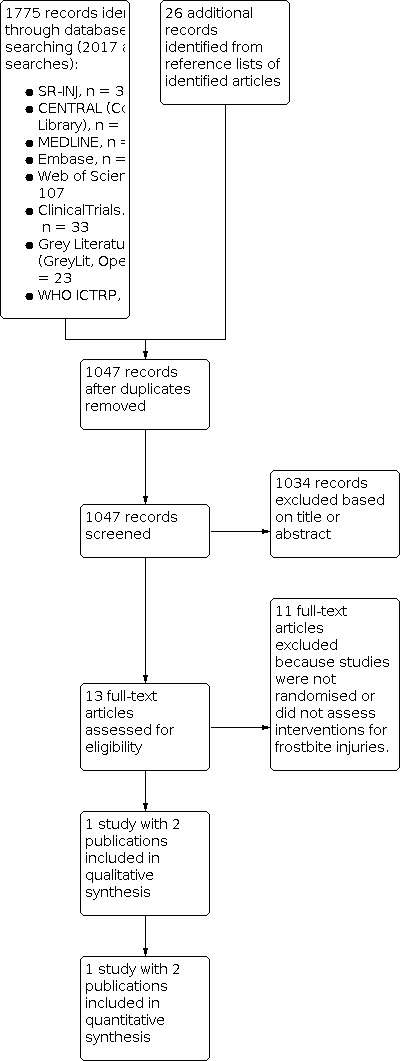
Study flow diagram
Included studies
We included one randomised trial with a total of 47 participants, which was published as a 'Letter to the Editor' in the New England Journal of Medicine (Cauchy 2011), and as a medical thesis (Cheguillaume 2011). The study population consisted of 44 men and three women with a mean age of 33 years (range 18 to 55 years). The participants were from 15 different countries. Forty‐five (95.7%) people acquired frostbite lesions during sport activities in altitudes over 2000 metres. Frostbite occurred in the feet of 33 participants, in the hands of 29, and in both the hands and feet of 15. Severe frostbite was defined as having at least one digit (finger or toe) with grade 3 frostbite (lesion extending just past the proximal phalanx) or grade 4 (lesion extending proximal to the metacarpal or metatarsal joint).
All participants who met the inclusion criteria (adults, no contraindications to use of aspirin or study drug, no severe trauma, no hypothermia, no mental conditions preventing co‐operation with the treatment) were included in the study directly after mountain rescue. All underwent rapid rewarming, received 250 mg of aspirin and 400 mg intravascular (IV) buflomedil, and were then randomised to one of three treatment groups for the following eight days.
Group 1 received additional IV buflomedil 400 mg for one hour per day.
Group 2 received an IV prostacyclin, iloprost, 0.5 ng/kg/min to 2 ng/kg/min for six hours per day.
Group 3 received IV iloprost 2 ng/kg/min for six hours per day plus fibrinolysis 100 mg rtPA for the first day only.
Treatment was evaluated after eight days by technetium bone scintigraphy, and participants were seen at follow‐up after three months.
Both iloprost and buflomedil were used off‐label.
We also found an ongoing randomised trial investigating the effect of hyperbaric oxygen on tissue regeneration, number of surgeries, level of amputation and level of function of the damaged body part after frostbite injury, registered in 2011 (NCT01270477). We attempted to contact the study authors inquiring about the status of the trial and preliminary data in May 2017, but received no reply.
Excluded studies
Our searches identified 1034 studies that had titles or abstracts which were clearly irrelevant to the subject of the review. We excluded 11 further studies after reading the full text of the articles. These studies were not randomised or did not assess interventions for frostbite injuries. The reasons for exclusion are described in the Characteristics of excluded studies.
Risk of bias in included studies
The one included study was considered to be a trial with an unclear risk of bias for one risk of bias domain (Cauchy 2011) (Figure 2; Figure 3).
2.

Risk of bias graph: review authors' judgements about each risk of bias item presented as percentages across all included studies.
3.
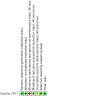
Risk of bias summary: review authors' judgements about each risk of bias item for each included study.
Allocation
The only included trial used a telephone service that was available 24 hours per day to randomise the people using a randomly generated list (Cheguillaume 2011). We judged risk of selection bias as being low.
Blinding
The one included trial was an open label study that did not report blinding of people, personnel and outcome assessors (Cauchy 2011). The three interventions differed substantially in their mode of administration (infusion over one hour versus infusion over six hours versus infusion over six hours plus a bolus). As such, it is hard to imagine that people and personnel were blinded to the intervention given. Therefore, we judged the risk of bias to be high for blinding of people and personnel.
The main outcome was amputation rate. Since amputation is not a subjective outcome, its evaluation cannot be subject to bias in assessors. Therefore, we judged the risk of bias due to lack of blinding of outcome assessors to be low.
Incomplete outcome data
The one included trial reported that there were no withdrawals from the study, and data from all 47 participants were given in the study. However, the supplementary material stated that seven people were not seen at the three‐month follow‐up (Cauchy 2011). Therefore, we judged the risk of bias for this domain to be unclear.
Selective reporting
Whilst it appears clear that a committee of the Rhône‐Alpes gave ethical approval for the study, no study protocol was available for the one included trial (nor was it common practice to produce one in 1996) (Cauchy 2011 ). The primary investigator for the study has died, and the medical thesis which also reports on the trial was not begun for more than 10 years after recruitment started (Cheguillaume 2011). In these circumstances, it was not possible to assess whether the outcomes were prespecified, or whether data were provided for all prespecified outcomes (Cauchy 2011).
It is our judgement, however, that all outcomes reported are relevant for this topic, and are patient‐relevant, and so we judged the study to have low risk of bias for selective reporting.
Other potential sources of bias
We identified no other sources of bias, including industry support.
Effects of interventions
See: Table 1; Table 2; Table 3
Summary of findings 1. Summary of findings.
| Iloprost versus buflomedil for frostbite injuries | |||||
|
Patient or population: people with severe frostbite injuries Settings: hospital Intervention: iloprost Comparison: buflomedil | |||||
| Outcomes | Illustrative comparative risks* | Relative effect (95% CI) | No of participants (studies) | Quality of the evidence (GRADE) | |
| Assumed risk | Corresponding risk | ||||
| Buflomedil | Iloprost | ||||
| Incidence of amputation in participants (3‐month follow‐up) |
Study population | RR 0.05; 95% CI 0.00 to 0.78 | 31 (1 study) | ⊕⊝⊝⊝ Very lowa |
|
| 9/15 | 0/16 | ||||
| Adverse events | ‐ | ‐ | ‐ | ‐ | Very lowb Not reported by intervention, but overall included flushing in 55% of participants, nausea in 25%, palpitations in 15%, and vomiting in 5%. |
| Acute pain | ‐ | ‐ | ‐ | ‐ | Not reported |
| Chronic pain | ‐ | ‐ | ‐ | ‐ | Not reported |
| Withdrawal from intervention due to adverse events | 0/15 | 0/16 | Not estimable | 31 (1 study) | ⊕⊝⊝⊝ Very lowc No withdrawals due to adverse events |
| Occupational effects | ‐ | ‐ | ‐ | ‐ | Not reported |
| Mortality | 0/15 | 0/16 | Not estimable | 31 (1 study) | ⊕⊝⊝⊝ Very lowc No deaths reported |
| *The basis for the assumed risk (e.g. the median control group risk across studies) is provided in footnotes. The corresponding risk is based on the assumed risk in the comparison group and the relative effect of the intervention (and its 95% CI). CI: confidence interval; RR: risk ratio | |||||
| GRADE Working Group grades of evidence: High quality: Further research is very unlikely to change our confidence in the estimate of effect. Moderate quality: Further research is likely to have an important impact on our confidence in the estimate of effect and may change the estimate. Low quality: Further research is very likely to have an important impact on our confidence in the estimate of effect and is likely to change the estimate. Very low quality: We are very uncertain about the estimate. | |||||
aQuality of the evidence is very low, and has been downgraded once for imprecision due to small participant number in one trial. We further downgraded the evidence (once for indirectness and once for risk of bias) because buflomedil, which was given to all participants as the primary treatment before randomisation, has been withdrawn from practice, yet may have influenced the effects seen in all active treatment groups.
bQuality of the evidence is very low, for reasons stated in footnote a (imprecision, indirectnesss and risk of bias). For this outcome, we downgraded the evidence a second time for indirectness, as evidence for adverse events was presented in crude rates, but not reported by intervention group.
cQuality of the evidence is very low, for reasons stated in footnote a (imprecision, indirectness and risk of bias). For this outcome, we downgraded the evidence a second time for imprecision, as this outcome is considered a rare event.
Summary of findings 2. Summary of findings.
| Iloprost + rtPA compared with buflomedil for frostbite injuries | |||||
|
Patient or population: people with severe frostbite injuries Settings: hospital Intervention: iloprost + rtPA Comparison: buflomedil | |||||
| Outcomes | Illustrative comparative risks* (95% CI) | Relative effect (95% CI) | No of Participants (studies) | Quality of the evidence (GRADE) | |
| Assumed risk | Corresponding risk | ||||
| Buflomedil | Iloprost + rtPA | ||||
| Incidence of amputation in participants (3‐month follow‐up) | Study population | RR 0.31; 95% CI 0.10 to 0.94 | 31 (1 study) | ⊕⊝⊝⊝ Verylowa | |
| 9/15 | 3/16 | ||||
| Adverse events | ‐ | ‐ | ‐ | ‐ | ⊕⊝⊝⊝ Very lowb Not reported by intervention, but overall included flushing in 55% of participants, nausea in 25%, palpitations in 15%, and vomiting in 5%. |
| Acute pain | ‐ | ‐ | ‐ | ‐ | Not reported |
| Chronic pain | ‐ | ‐ | ‐ | ‐ | Not reported |
| Withdrawal from intervention due to adverse events | 0/15 | 0/16 | Not estimable | 31 (1 study) | ⊕⊝⊝⊝ Very lowc No withdrawals due to adverse events |
| Occupational effects | ‐ | ‐ | ‐ | ‐ | Not reported |
| Mortality | 0/15 | 0/16 | Not estimable | 31 (1 study) | ⊕⊝⊝⊝ Very lowc No deaths reported |
| *The basis for the assumed risk (e.g. the median control group risk across studies) is provided in footnotes. The corresponding risk is based on the assumed risk in the comparison group and the relative effect of the intervention (and its 95% CI). CI: confidence interval; RR: risk ratio | |||||
| GRADE Working Group grades of evidence: High quality: Further research is very unlikely to change our confidence in the estimate of effect. Moderate quality: Further research is likely to have an important impact on our confidence in the estimate of effect and may change the estimate. Low quality: Further research is very likely to have an important impact on our confidence in the estimate of effect and is likely to change the estimate. Very low quality: We are very uncertain about the estimate. | |||||
aQuality of the evidence is very low, and has been downgraded once for imprecision due to small participant number in one trial. We further downgraded the evidence (once for indirectness and once for risk of bias) because buflomedil, which was given to all participants as the primary treatment before randomisation, has been withdrawn from practice, yet may have influenced the effects seen in all active treatment groups.
bQuality of the evidence is very low, for reasons stated in footnote a (imprecision, indirectnesss and risk of bias). For this outcome, we downgraded the evidence a second time for indirectness, as evidence for adverse events was presented in crude rates, but not reported by intervention group.
cQuality of the evidence is very low, for reasons stated in footnote a (imprecision, indirectness and risk of bias). For this outcome, we downgraded the evidence a second time for imprecision, as this outcome is considered a rare event.
Summary of findings 3. Summary of findings.
| Iloprost +rtPA compared with iloprost for frostbite injuries | |||||
|
Patient or population: people with severe frostbite injuries Settings: hospital Intervention: iloprost + rtPA Comparison: iloprost | |||||
| Outcomes | Illustrative comparative risks* (95% CI) | Relative effect (95% CI) | No of participants (studies) | Quality of the evidence (GRADE) | |
| Assumed risk | Corresponding risk | ||||
| Iloprost | Iloprost + rtPA | ||||
| Incidence of amputations in participants (3‐month follow‐up) | Study population | RR 0.14; 95% CI 0.01 to 2.56 | 32 (1 study) | ⊕⊝⊝⊝ Very lowa | |
| 0/16 | 3/16 | ||||
| Adverse events | ‐ | ‐ | ‐ | ‐ | ⊕⊝⊝⊝ Very lowb Not reported by intervention, but overall included flushing in 55% of participants, nausea in 25%, palpitations in 15%, and vomiting in 5%. |
| Acute pain | ‐ | ‐ | ‐ | ‐ | Not reported |
| Chronic pain | ‐ | ‐ | ‐ | ‐ | Not reported |
| Withdrawal from intervention due to adverse events | 0/16 | 0/16 | Not estimable | 32 (1 study) | ⊕⊝⊝⊝ Very lowc No withdrawals due to adverse events |
| Occupational effects | ‐ | ‐ | ‐ | ‐ | Not reported |
| Mortality | 0/16 | 0/16 | Not estimable | 32 (1 study) | ⊕⊝⊝⊝ Very lowc No deaths reported |
| *The basis for the assumed risk (e.g. the median control group risk across studies) is provided in footnotes. The corresponding risk is based on the assumed risk in the comparison group and the relative effect of the intervention (and its 95% CI). CI: confidence interval; RR: risk ratio | |||||
| GRADE Working Group grades of evidence: High quality: Further research is very unlikely to change our confidence in the estimate of effect. Moderate quality: Further research is likely to have an important impact on our confidence in the estimate of effect and may change the estimate. Low quality: Further research is very likely to have an important impact on our confidence in the estimate of effect and is likely to change the estimate. Very low quality: We are very uncertain about the estimate. | |||||
aQuality of the evidence is very low, and has been downgraded once for imprecision due to small participant number in one trial. We further downgraded the evidence (once for indirectness and once for risk of bias) because buflomedil, which was given to all participants as the primary treatment before randomisation, has been withdrawn from practice, yet may have influenced the effects seen in all active treatment groups.
bQuality of the evidence is very low, for reasons stated in footnote a (imprecision, indirectnesss and risk of bias). For this outcome, we downgraded the evidence a second time for indirectness, as evidence for adverse events was presented in crude rates, but not reported by intervention group.
cQuality of the evidence is very low, for reasons stated in footnote a (imprecision, indirectness and risk of bias). For this outcome, we downgraded the evidence a second time for imprecision, as this outcome is considered a rare event.
Amputations
The one included trial reported the incidence of amputations on both the participant level and body‐part (fingers and toes) level.
Participant level
Amputations were much less common in:
the iloprost group (0/16; 0%) compared to the buflomedil group (9/15; 60%; RR 0.05, 95% CI 0.00 to 0.78; 1 study, 47 participants; very low‐quality evidence; Analysis 1.1), and
the iloprost plus rtPA group (3/16; 19%) compared to the buflomedil group (9/15; 60%; RR 0.31, 95% CI 0.10 to 0.94; 1 study, 47 participants; very low‐quality evidence; Analysis 2.1).
1.1. Analysis.
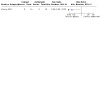
Comparison 1: Iloprost vs buflomedil, Outcome 1: Incidence of amputations (patients)
2.1. Analysis.
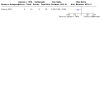
Comparison 2: Iloprost + rtPA vs buflomedil, Outcome 1: Incidence of amputations (patients)
There may have been little or no difference between the iloprost group (0/16; 0%) and the iloprost plus rtPA group (3/16; 19%; RR 0.14, 95% CI 0.01 to 2.56; 1 study, 47 participants, very low‐quality evidence; Analysis 3.1).
3.1. Analysis.
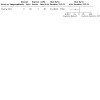
Comparison 3: Iloprost vs iloprost + rtPA, Outcome 1: Incidence of amputations (patients)
Body‐part level
A total of 407 digits were frostbitten in the 47 participants, and 47 of these (11.5%) were amputated from 12 individuals. Forty‐two of the 106 (39.6%) frostbitten digits treated with buflomedil were amputated. None of 142 frostbitten digits treated with iloprost were amputated. Five of the 159 frostbitten digits treated with iloprost plus rtPA were amputated. We analysed the data by applying the method for cluster randomised trials, and calculated an effective sample size in the control/treatment group as well as the modified number of events.
This showed that:
amputations may have occurred less often in the iloprost group (0/142; 0%) compared to the buflomedil group (42/106; 39.6%; RR 0.01, 95% CI 0.01 to 0.14; 1 study, 47 participants; very low‐quality evidence; Analysis 1.2);
amputations may have occurred less often in the iloprost plus rtPA group (5/159; 3%) compared to the buflomedil group (42/106; 39.6%; RR 0.08, 95% CI 0.03 to 0.19; 1 study, 47 participants; very low‐quality evidence; Analysis 2.2);
there may be little or no difference in amputations between the iloprost group (0/142; 0%) and the iloprost plus rtPA group (5/159; 3%; RR 0.10, 95% CI 0.01 to 1.82; 1 study, 47 participants; very low‐quality evidence; Analysis 3.2).
1.2. Analysis.
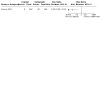
Comparison 1: Iloprost vs buflomedil, Outcome 2: Incidence of amputations (body parts)
2.2. Analysis.
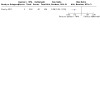
Comparison 2: Iloprost + rtPA vs buflomedil, Outcome 2: Incidence of amputations (body parts)
3.2. Analysis.
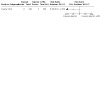
Comparison 3: Iloprost vs iloprost + rtPA, Outcome 2: Incidence of amputations (body parts)
Adverse effects
Adverse events were reported for all the included people regardless of intervention, but were not reported separately by comparator arm. Therefore, we could not assess whether the rate of serious and non‐serious adverse events differed in the intervention groups, and assessed the evidence as being of very low quality. Adverse events included hot flushes in 55% of participants, nausea in 25%, heart palpitations in 15%, and vomiting in 5%. Despite this, the study reported no withdrawals due to adverse events.
Withdrawal from the study due to adverse events
None of the participants withdrew from the study due to reactions to the study medication (very low‐quality evidence).
Mortality
The only included study did not report any deaths. As this is a small study, and the event is anticipated to be rare, we assessed this finding as being of very low quality.
Other outcomes
The only included study did not report on our prespecified outcomes acute pain, chronic pain, ability to perform activities of daily living, quality of life and occupational events.
Subgroup analyses
Superficial versus deep frostbite injuries
Superficial frostbite injuries (grade 2) affected a total of 155 digits, and deep frostbite injuries (grades 3 and 4 combined) affected 252 digits. Four amputations occurred in the superficial frostbite group, versus 43 in the deep frostbite group. For superficial frostbite injuries, two of 31 digits were amputated in the group treated with buflomedil. In the iloprost group, none of the 64 digits were amputated. For the iloprost plus rtPA group, two of 60 affected digits were amputated. For deep frostbite injuries, 40 out of 75 affected digits were amputated in the buflomedil group, none of the 78 digits in the iloprost group, and three of the 99 digits in the iloprost plus rtPA group. See Analysis 1.3; Analysis 2.3; Analysis 3.3.
1.3. Analysis.
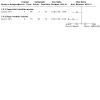
Comparison 1: Iloprost vs buflomedil, Outcome 3: Incidence of amputations (severity)
2.3. Analysis.
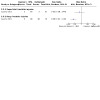
Comparison 2: Iloprost + rtPA vs buflomedil, Outcome 3: Incidence of amputations (severity)
3.3. Analysis.
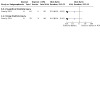
Comparison 3: Iloprost vs iloprost + rtPA, Outcome 3: Incidence of amputations (severity)
Treatment initiated within or after 12 hours
We initially planned a subgroup analysis investigating time to medical intervention within or after 24 hours of injury. As the only included study did not report data within these time frames, we were not able to perform the initially specified subgroup analysis. However, the only included study did report amputation rates for all grades of frostbite injury treated within or after 12 hours.
A total of 271 digits received medical treatment within 12 hours of injury, of which 13 (4.8%) were amputated. A further 136 digits presented more than 12 hours after injury, and 34 (25%) were amputated. This shows that risk for amputation was significantly reduced in the participants who received any treatment within 12 hours (13/271 = 4.8%) compared with the group who received treatment after 12 hours (34/136 = 25%) (P < 0.001, Fischer's exact test) (Analysis 1.4; Analysis 2.4; Analysis 3.4).
1.4. Analysis.
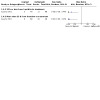
Comparison 1: Iloprost vs buflomedil, Outcome 4: Incidents of amputations (time)
2.4. Analysis.
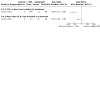
Comparison 2: Iloprost + rtPA vs buflomedil, Outcome 4: Incidence of amputations (time)
3.4. Analysis.
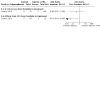
Comparison 3: Iloprost vs iloprost + rtPA, Outcome 4: Incidence of amputations (time)
For the groups presenting for treatment within 12 hours: none of the 79 digits in the iloprost group were amputated; two of the 144 digits in the iloprost plus rtPA group were amputated; and 11 of the 48 digits in the buflomedil group were amputated.
For the groups presenting for treatment after 12 hours: none of the 63 digits in the iloprost group were amputated; three of the 15 digits in the iloprost plus rtPA group were amputated; and 31 of the 58 digits in the buflomedil group were amputated.
Discussion
Summary of main results
Evidence from randomised trials on interventions for frostbite injuries is very limited. We found one small randomised controlled three‐arm trial comparing buflomedil, iloprost, and iloprost combined with fibrinolysis (rtPA) (Cauchy 2011). The trial suggests that iloprost and iloprost plus rtPA may result in a large reduction in the rate of amputations compared to buflomedil alone, when analysed on both patient and body‐part levels (very low‐quality evidence). There may be little or no difference in amputations between iloprost and iloprost plus rtPA (very low‐quality evidence). There were no deaths or withdrawals due to adverse events in any of the study arms (very low‐quality evidence). The included study provided very low‐quality evidence on adverse events, which it did not report separately by comparator arm, and it did not measure the outcomes of acute pain, chronic pain, ability to perform activities of daily living, quality of life or occupational effects.
Overall completeness and applicability of evidence
There is a paucity of evidence in this field, and drawing conclusions from a very small evidence base is difficult. This systematic review examined the evidence from one included RCT comparing three interventions for the treatment of frostbite injuries. We could not obtain data for all our predefined outcome measures, as the trial did not report on all of them. The trial reported on amputations and mortality, but did not report the adverse events by comparator arm. We do know, however, that there were no withdrawals due to adverse events, and no deaths.
Iloprost and rtPA are still available on the market. However, buflomedil, which was given to all people as the primary treatment in this study before randomisation to the three interventional groups, has been withdrawn because of reports of severe adverse neurological and cardiac events after its administration. This means that the treatment option which was given to all three groups before randomisation and to one group after randomisation can no longer be administered. In the absence of a control group that did not receive buflomedil, we cannot be sure that the effects seen in the iloprost and iloprost plus rtPA groups were not influenced by buflomedil. This factor caused us to downgrade the evidence for indirectness.
The trial included participants with severe frostbite injuries (grades 3 and 4), but some also presented with grade 2 injuries. A subgroup analysis showed that the iloprost interventions reduced the amputation rate for both severe and superficial frostbite injuries. Frostbite injuries of grades 1 and 2 do not usually lead to amputations, but grades 3 and 4 usually do. The population included in this trial was relevant to the review question, and included no restrictions regarding age and sex, so indirectness is not an issue with regard to the target population.
The only included trial investigated the effect of buflomedil, iloprost and rtPA on amputation rates. We found no trials investigating rewarming techniques, Aloe vera treatment, sympathectomy or other interventions for frostbite injuries. Therefore, the evidence in this review lacks completeness in terms of breadth of scope.
Quality of the evidence
The included trial was poorly reported and the methods were not sufficiently well described to enable us to assess attrition bias. The study did not report blinding of participants, personnel or outcome assessors. Due to the differences in the interventions given, we judged the risk of bias to be high for blinding of people and personnel. However, as the nature of the main outcome was objective, and could hardly be subject to bias in assessors, we judged the risk of bias due to lack of blinding of outcome assessors to be low. We also assessed the risk of bias to be low for the domains of sequence generation, allocation concealment and selective outcome reporting. We downgraded for risk of bias.
Our primary concern regarding this evidence base was imprecision. The only included study recruited 47 participants, yet our sample size calculation showed that a minimum of 416 participants total, or 209 participants in each arm, would be required to have a sufficiently powered study to calculate a precise effect estimate. Therefore our review is very underpowered and the consequent imprecision, for which we downgraded, means that we have greatly reduced confidence in the effect estimates.
The included study recruited a representative population of adults of both sexes, focused on severe frostbite injuries but also included extremities with superficial frostbite injuries (i.e. grade 2 frostbite). Regarding these domains, we did not consider indirectness to be of concern. However, all intervention groups received buflomedil, and as no control group was present that did not receive buflomedil, we cannot be certain whether the administration of buflomedil influenced the effect seen in the iloprost and iloprost plus rtPA group. This caused us to downgrade for indirectness. Likewise, we did not have concerns about inconsistency. We could not detect publication bias via a funnel plot as there were insufficient studies. However, we do not suspect publication bias: we did not find any registered trials that had not been published, and we suspect that there are very few studies in this field because of how difficult they are to coordinate and conduct.
Potential biases in the review process
We performed a comprehensive literature search for this systematic review across languages and including trial registries. We prespecified inclusion and exclusion criteria, and two authors independently screened studies and extracted data in order to reduce bias. However, only one RCT was eligible for inclusion, and we found one ongoing trial. This means that it is very difficult to draw conclusions because the evidence base is so limited.
We acknowledge that the judgements regarding risk of bias and GRADE have an element of subjectivity which may have introduced some bias into the review process.
Agreements and disagreements with other studies or reviews
No other meta‐analysis on interventions for frostbite injuries has been published, although Hutchinson and colleagues published a systematic review in 2019 (Hutchinson 2019). This included cohort studies and case reports that investigated the use of tissue plasminogen activator (tPA) for the treatment of frostbite injuries, in addition to the RCT included in this review. Due to a high degree of heterogeneity in the treatment protocols, inclusion criteria and outcome measures, Hutchinson and colleagues performed no meta‐analysis. The included trials reported that tPA may have been useful in reducing amputation rates. Due to low quality evidence, the authors concluded that the efficacy of tPA in reducing amputation rates cannot be established. This conclusion is in agreement with the findings of this review.
In 1994, a small study reported on treatment of four patients with severe frostbite with iloprost, in which no amputations occurred (Groechenig 1994). Even though these results were very promising, no other studies with iloprost were published until the randomised trial included in this review (Cauchy 2011). In contrast, some non‐randomised studies report on the use of rtPA with promising results (Bruen 2007; Twomey 2005). In one retrospective review, digital amputations occurred at a rate of 41% in patients that did not receive rtPA compared to 10% in those who received rtPA within 24 hours of injury (P < 0.05) (Bruen 2007). In another case‐series, the number of amputations of digits in patients who had an absence of Doppler pulses and no perfusion with a technetium (Tc) 99m three‐phase bone scan, was much lower than expected after treatment with rtPA (Twomey 2005). In this study, some patients received rtPA intra‐arterially and some intravenously. Two of the patients treated intra‐arterially suffered bleeding complications (Twomey 2005). Administration of rtPA requires a facility used to giving thrombolysis, and adequate intensive monitoring facilities (Handford 2014). Furthermore, rtPA is contraindicated with presence of trauma or increased bleeding risk due to the risk of haemorrhage.
Authors' conclusions
Implications for practice.
There is a paucity of evidence regarding interventions for frostbite injuries. This review indicates that iloprost and iloprost combined with recombinant tissue plasminogen activator (rtPA) may reduce the rate of amputations in people with severe frostbite compared to buflomedil alone. The quality of evidence is very low due to the fact that there was only one randomised trial with a small number of participants, an unclear risk of bias, and the use of buflomedil has since been discontinued.
More high‐quality randomised trials are needed to establish firm evidence for the treatment of frostbite injuries.
Implications for research.
Evidence from randomised trials on interventions for frostbite injuries is limited, and we have only very low‐quality evidence from one randomised trial with a limited number of outcomes. The number of people with severe frostbite lesions presenting at a single institution is limited, so interventions for frostbite lesions should be studied in a multicenter trial to increase the number of participants included and to reduce study duration.
Our results suggest that such appropriately‐sized, multicenter, randomised trials are warranted to investigate iloprost further. The only included randomised trial in this review did not find an additional benefit of adding rtPA to iloprost treatment. The benefit of rtPA alone or in combination with iloprost should be investigated in future randomised trials. As far as possible, these trials should be conducted to minimise the risk of bias and should follow the CONSORT guidelines.
Alongside risk of amputation, future trials should also study long‐term outcomes of frostbite injury, such as chronic neuropathy, hand function and quality of life.
History
Protocol first published: Issue 3, 2018 Review first published: Issue 12, 2020
Acknowledgements
We would like to thank the Cochrane Injuries Group for their support in preparing this review. We would like to thank the Cochrane Information Specialists, Sarah Dawson, who designed and ran the 2017 search, and Jane Dennis, who obtained a copy of the thesis on which the Cauchy trial was based; and Kate Perris, Assistant Librarian at the London School of Hygiene and Tropical Medicine, who ran the updated 2020 search.
We acknowledge with gratitude the contributions of Jean‐Hugues Morneau and colleagues of the academic library network of Grenoble Alpes University for assistance regarding the acquisition of Dr Benoit Cheguillaume's thesis and for helping with contact details of the author himself. We also thank Dr Cheguillaume for his time and for valuable information (Cheguillaume 2020 [pers comm]).
This project was supported by the UK National Institute for Health Research, through Cochrane Infrastructure funding to the Cochrane Injuries Group. The views and opinions expressed are those of the authors and do not necessarily reflect those of the Systematic Reviews Programme, NIHR, NHS or the Department of Health.
Appendices
Appendix 1. Search strategies (original, 2017)
1. SR‐INJ
(frostbit* or “frost bit*” or frostnip* or “frost nip*” or “frost injury” or chilblain* or pernio* or "cold injur*" or "cold burn*" or “freeze* injur*”) IN SEGMENT
2. CENTRAL, Cochrane Library
#1 MeSH descriptor: [Cold Injury] explode all trees
#2 (frostbit* or "frost bit*" or frostnip* or "frost nip*" or chilblain* or pernio* or ((cold or frost or freez*) next (injur* or burn or burns or damage*)))
#3 (frost* or freezing or sub‐zero or winter or wintertime or (cold next (climat* or environment* or exposure* or exposed or temperature*)) or hypothermia or "high altitude*" or ((northern or high) next latitude*) or arctic or antarctic or polar or circumpolar*)
#4 ((extremities or digit or digits or distal phalanx or limb or limbs or hand or hands of finger or fingers or foot or feet or toe or toes or nose or ear or ears or lip or lips or cheek or cheeks) near (injur* or damag* or destruct* or vasoconstrict* or vasodilat* or erythema or edema or odema or desquam* or blister* or "ice crystal*" or isc?emi* or cyanos* or necro* or gangren*))
#5 #1 or #2 or (#3 and #4)
3. Ovid MEDLINE(R) Epub Ahead of Print, In‐Process & Other Non‐Indexed Citations, Ovid MEDLINE(R) Daily and Ovid MEDLINE(R) 1946 to present
exp Cold Injury/
(frostbit* or frost bit* or frostnip* or frost nip* or chilblain* or pernio* or ((cold or frost or freezing) adj (injur* or burn? or damage*))).ti,ab,kf.
(frost* or forfrysning* or paletuma or otmorozheni*).ot.
or/1‐3
((extremities or digit? or distal phalanx or limb? or hand? of finger? or foot or feet or toe? or nose or ear? or lip? or cheek?) and (injur* or damag* or destruct* or vasoconstrict* or vasodilat* or erythema or edema or odema or desquam* or blister* or ice crystal* or freeze‐thaw or isc?emi* or cyanos* or necro* or gangren*)).mp.
cold temperature/ or freezing/
(frost* or freezing or sub‐zero or winter or wintertime or (cold adj (climat* or environment* or exposure* or exposed or temperature*)) or hypothermia or high altitude* or ((northern or high) adj latitude*) or arctic or antarctic or polar or circumpolar*).ti,ab,kf.
5 and (6 or 7)
4 or 8
randomi#ed.ab,ti.
randomized controlled trial.pt.
controlled clinical trial.pt.
placebo.ab.
clinical trials as topic.sh.
double blind method.sh.
randomly.ab.
(RCT or at random or (random* adj (assign* or allocat* or divid* or division or number))).ti,ab,kf.
trial.ti.
or/10‐18
(animals not (humans and animals)).sh.
19 not 20
9 and 21
(rat or rats or rodent* or mice or mouse or murine).ti.
22 not 23
remove duplicates from 24
4. Ovid Embase 1974 to date
Cold Injury/ or Chilblain/ or Frostbite/
(frostbit* or frost bit* or frostnip* or frost nip* or chilblain* or pernio* or ((cold or frost or freezing) adj (injur* or burn? or damage*))).ti,ab,kw.
(frost* or forfrysning* or paletuma or otmorozheni*).ot.
or/1‐3
randomized controlled trial/
controlled clinical trial/
randomi#ed.ti,ab,kw.
randomization/
placebo.ti,ab,kw.
placebo/
*Clinical Trial/
((singl* or doubl* or trebl* or tripl*) adj3 (blind* or mask* or dummy)).ti,ab,kw.
double blind procedure/
(RCT or at random or (random* adj (assign* or allocat* or divid* or division or number))).ti,ab,kw.
trial.ti.
or/5‐15
((animal or nonhuman) not (human and (animal or nonhuman))).de.
16 not 17
4 and 18
(rat or rats or rodent* or mice or mouse or murine or rabbit*).ti.
19 not 20
remove duplicates from 21
5. Web of Science (WoS) 1970 to date
Indexes=SCI‐EXPANDED, CPCI‐S, CPCI‐SSH, ESCI Timespan=All years
TS=((frostbit* or "frost bit*" or frostnip* or "frost nip*" or "frost injury" or "frost burn*" or chilblain* or pernio* or "cold injur*" or "cold burn*" or “freez* injur*”) AND (RCT or random* or placebo or blind* or mask*)) NOT TI=(rat or rats or rabbit* or rodent* or mice or mouse or murine)
Appendix 2. Search strategies (updated, 2020)
1 Search methodology
In February 2020, the search strategies used in the 2017 review were used as the basis for the new searches. An updated draft search strategy was compiled in the OvidSP MEDLINE database by an experienced information specialist. The search strategy included strings of terms, synonyms and controlled vocabulary terms (where available) to reflect the concept of frostbite including related terms covering freezing damage to extremities, cold temperatures and high altitudes and polar climates.
The Cochrane sensitive randomised controlled trials filters for MEDLINE and Embase were updated. No other filters or limits were added. The MEDLINE search was adapted for each database to incorporate database‐specific syntax and controlled vocabularies. Full details of the search strings used for each database can be found in the appendix.
1.1 Edits made to the search from the 2017 search
The 2017 search strategies included terms for frostnip and chilblains but the team did not include these conditions in their results so related words removed from the search terms used. The updated Ovid MEDLINE Cochrane Highly Sensitive Search Strategy for identifying randomised trials was added to the MEDLINE search, and the most up to date Embase filter developed by the UK Cochrane Centre was added to the Embase search (Lefebvre 2019). No filters were added to other databases. Full details of changes to the search strings are found in the appendix.
The Cochrane Injuries Group Specialised Register was not searched in 2020, as its contents are included as part of CENTRAL.
1.2.1 Databases
The following databases were searched on 25 February 2020.
Cochrane Central Register of Controlled Trials, Issue 2 of 12, February 2020
Ovid MEDLINE(R) and Epub Ahead of Print, In‐Process & Other Non‐Indexed Citations and Daily ‐ without Revisions 1947 to 7 February 2020
Embase 1974 to 11 February 2020
-
Web of Science Core Collection databases, data last updated 2020‐02‐24:
Science Citation Index Expanded (SCI‐EXPANDED) ‐ 1970 to 25 February 2020
Conference Proceedings Citation Index ‐ Science (CPCI‐S) ‐ 1990 to 25 February 2020
1.3 Information management
All citations identified by our searches were imported into EndNote X9 software. Duplicates were identified and removed using the method described on the LAS blog (Falconer 2018).
2 Results
A total of 1221 results were retrieved by the search; 585 (48%) were identified as duplicates, including duplicates from the 2017 search. Number of results pre‐and post‐deduplication are listed in the table below.
| Database name | Total number of results | Number of results once duplicates removed |
| Cochrane Central Register of Controlled Trials, Issue 2 of 12, February 2020 | 385 | 104 |
| Ovid MEDLINE(R) and Epub Ahead of Print, In‐Process & Other Non‐Indexed Citations and Daily ‐ without Revisions 1947 to 7 February 2020 | 247 | 117 |
| Embase 1974 to 11 February 2020 | 482 | 378 |
| Web of Science Core Collection 1970 to 25 February 2020 | 107 | 37 |
| Total | 1221 | 636 |
3 Search strategies
Full details of all search strings used for bibliographic databases, with dates and number of references returned and notes explaining any unusual search techniques or syntax, and differences from the 2017 search strategies follow. The EndNote X9 import order is provided, as the deduplication technique keeps the first uploaded copy of the reference by default.
In all searches, numbers in parentheses at the end of each row show the number of hits retrieved.
3.1 Cochrane Central Register of Controlled Trials
| Database name | Cochrane Central Register of Controlled Trials |
| Database platform | Wiley |
| Dates of database coverage | Issue 2 of 12, Febuary 2020 |
| Date searched | 25 February 2020 |
| Searched by | KP |
| Number of results | 385 (search below shows number of results for all Cochrane Library databases, only CENTRAL results included in the review). |
| EndNote import order | 4 |
| Number of results once duplicates removed | 104 |
| Search strategy notes | * is used for truncation. ? is used for optional wildcard Searches ending:ti,ab,kw search the title, abstract and keywords. near/n searches for words within n words of each other. The Cochrane Randomised Controlled Trial filter is not used here, as all results should be RCTs. |
| Edits from 2017 search strategies | Search was edited to map more closely to MEDLINE search. Use of NEXT and NEAR were amended to bring in line with MEDLINE search. Frostnip and Chilblains were removed from the search as these concepts are outside the scope of the search. |
#1 MeSH descriptor: [Cold Injury] explode all trees (15)
#2 ((frostbit* or (frost NEXT bit*) or pernio*)):ti,ab,kw (61)
#3 ((cold or frost or freezing) NEAR/1 (injur* or burn? or damage*)):ti,ab,kw (58)
#4 (((extremities or digit? or "distal phalanx" or limb? or hand? or finger? or foot or feet or toe? or nose or ear? or lip? or cheek?) and (injur* or damag* or destruct* or vasoconstrict* or vasodilat* or erythema or edema or odema or desquam* or blister* or (ice NEXT crystal*) or freeze‐thaw or isc?emi* or cyanos* or necro* or gangren*))):ti,ab,kw (17,125)
#5 MeSH descriptor: [Cold Temperature] this term only (1384)
#6 MeSH descriptor: [Freezing] this term only (99)
#7 ((frost* or freezing or sub‐zero or winter or wintertime or (cold NEAR/1 (climat* or environment* or exposure* or exposed or temperature*)) or hypothermia or (high NEXT altitude*) or ((northern or high) NEAR/1 latitude*) or arctic or antarctic or polar or circumpolar*)):ti,ab,kw (10,538)
#8 #1 OR #2 OR #3 (112)
#9 #5 OR #6 (1481)
#10 #4 AND (#7 OR #9) (305)
#11 #8 OR #10 (393)
3.2 OvidSP Embase Classic + Embase
| Database name | Embase Classic + Embase |
| Database platform | OvidSP |
| Dates of database coverage | 1947 to 28 January 2020 |
| Date searched | 25 February 2020 |
| Searched by | KP |
| Number of results | 482 |
| EndNote import order | 2 |
| Number of results once duplicates removed | 378 |
| Search strategy notes | Search lines ending in a ‘/’ are subject heading searches. Search lines beginning ‘exp’ are exploded subject heading searches. Search lines ending in .ti,ab,kw,dy. search in the title, abstract, author keywords and drug registry number fields only. Search lines ending in .ti,ab. search in the title and abstract fields only. Search lines ending in .ab. search in the abstract field only. Search lines ending in .ti. search in the title field only. Search lines ending in.pt. search in the publication type field. or/x‐y combines search sets in the range x‐y with Boolean operator OR. * is used for truncation of words. ? is used for optional wildcards. adjn searches for words within n words of each other. $n searches for words with 0‐n letters after the $. |
| Edits from 2017 search strategies | Edited search terms:
|
1 Cold Injury/ or Frostbite/ (5016)
2 (frostbit* or frost bit* or pernio* or ((cold or frost or freezing) adj (injur* or burn? or damage*))).ti,ab,kw. (4529)
3 (frost* or forfrysning* or paletuma or otmorozheni*).ot. (175)
4 or/1‐3 (6847)
5 exp randomized controlled trial/ (594,802)
6 randomized controlled trial/ (594,202)
7 controlled clinical study/ (463,354)
8 6 or 7 (779,784)
9 random*.ti,ab. (1,517,346)
10 randomization/ (86,166)
11 intermethod comparison/ (256,962)
12 placebo.ti,ab. (306,478)
13 (compare or compared or comparison).ti. (532,396)
14 ((evaluated or evaluate or evaluating or assessed or assess) and (compare or compared or comparing or comparison)).ab. (2,071,840)
15 (open adj label).ti,ab. (77,181)
16 ((double or single or doubly or singly) adj (blind or blinded or blindly)).ti,ab. (234,062)
17 double blind procedure/ (172,353)
18 parallel group$1.ti,ab. (25,039)
19 (crossover or cross over).ti,ab. (104,636)
20 ((assign* or match or matched or allocation) adj5 (alternate or group$1 or intervention$1 or patient$1 or subject$1 or participant$1)).ti,ab. (325,413)
21 (assigned or allocated).ti,ab. (382,895)
22 (controlled adj7 (study or design or trial)).ti,ab. (344,227)
23 (volunteer or volunteers).ti,ab. (249,633)
24 human experiment/ (486,296)
25 trial.ti. (300,074)
26 or/9‐25 (4,837,073)
27 26 not 8 (4,209,248)
28 (random* adj sampl* adj7 ("cross section*" or questionnaire$1 or survey* or database$1)).ti,ab. not (comparative study/ or controlled study/ or randomi?ed controlled.ti,ab. or randomly assigned.ti,ab.) (8074)
29 cross‐sectional study/ not (randomized controlled trial/ or controlled clinical study/ or controlled study/ or (randomi?ed controlled or control group$1).ti,ab.) (229,256)
30 (((case adj control*) and random*) not randomi?ed controlled).ti,ab. (16,872)
31 (systematic review not (trial or study)).ti. (136,258)
32 (nonrandom* not random*).ti,ab. (16,033)
33 "random field*".ti,ab. (2250)
34 (random cluster adj3 sampl*).ti,ab. (1254)
35 (review.ab. and review.pt.) not trial.ti. (779,459)
36 "we searched".ab. and (review.ti. or review.pt.) (30,771)
37 "update review".ab. (103)
38 (databases adj4 searched).ab. (33,823)
39 (rat or rats or mouse or mice or swine or porcine or murine or sheep or lambs or pigs or piglets or rabbit or rabbits or cat or cats or dog or dogs or cattle or bovine or monkey or monkeys or trout or marmoset$1).ti. and animal experiment/ (1,047,014)
40 Animal experiment/ not (human experiment/ or human/) (2,219,842)
41 or/28‐40 (3,406,513)
42 27 not 41 (3,695,042)
43 5 or 42 (4,289,547)
44 4 and 43 (487)
45 remove duplicates from 44 (482)
3.3 OvidSP MEDLINE
| Database name | MEDLINE |
| Database platform | OvidSP |
| Dates of database coverage | Ovid MEDLINE(R) and Epub Ahead of Print, In‐Process & Other Non‐Indexed Citations, Daily and Versions(R) 1946 to February 24, 2020 |
| Date searched | 25 February 2020 |
| Searched by | KP |
| Number of results | 247 |
| EndNote import order | 1 |
| Number of results once duplicates removed | 117 |
| Search strategy notes | Search lines ending in a ‘/’ are subject heading searches. Search lines beginning ‘exp’ are exploded subject heading searches. Search lines ending in .ti,ab,kf,rn. search in the title, abstract, author keywords and drug registry number fields only. Search lines ending in .ti,ab. search in the title and abstract fields only. Search lines ending in .ab. search in the abstract field only. Search lines ending in .pt. search in the publication type field. Search lines ending in .sh. search in the subject heading field. Search lines ending in.fs. search in the subject heading subheadings field. or/x‐y combines search sets in the range x‐y with Boolean operator OR. * is used for truncation of words. ? is used for optional wildcards. adjn searches for words within n words of each other. |
| Edits from 2017 search strategies | Edited search terms:
|
1 exp Cold Injury/ (2121)
2 (frostbit* or frost bit* or pernio* or ((cold or frost or freezing) adj (injur* or burn? or damage*))).ti,ab,kf. (3581)
3 (frost* or forfrysning* or paletuma or otmorozheni*).ot. (174)
4 or/1‐3 (4201)
5 ((extremities or digit? or distal phalanx or limb? or hand? or finger? or foot or feet or toe? or nose or ear? or lip? or cheek?) and (injur* or damag* or destruct* or vasoconstrict* or vasodilat* or erythema or edema or odema or oedema or desquam* or blister* or ice crystal* or freeze‐thaw or isc?emi* or cyanos* or necro* or gangren*)).mp. (211,617)
6 cold temperature/ or freezing/ (73,150)
7 (frost* or freezing or sub‐zero or winter or wintertime or (cold adj (climat* or environment* or exposure* or exposed or temperature*)) or hypothermia or high altitude* or ((northern or high) adj latitude*) or arctic or Antarctic* or polar or circumpolar*).ti,ab,kf. (232,368)
8 5 and (6 or 7) (3286)
9 4 or 8 (6849)
10 randomized controlled trial.pt. (500,275)
11 controlled clinical trial.pt. (93,540)
12 randomized.ab. (469,715)
13 placebo.ab. (204,980)
14 clinical trials as topic.sh. (190,142)
15 randomly.ab. (327,241)
16 trial.ti. (213,153)
17 10 or 11 or 12 or 13 or 14 or 15 or 16 (1,268,791)
18 exp animals/ not humans.sh. (4,671,567)
19 17 not 18 (1,166,997)
20 9 and 19 (247)
21 remove duplicates from 20 (247)
3.4 Web of Science databases
| Database name | Web of Science Core Collection, consisting of the following databases:
|
| Database platform | Clarivate Analytics |
| Dates of database coverage |
Data last updated 24 February 2020 |
| Date searched | 25 February 2020 |
| Searched by | KP |
| Number of results | 107 |
| EndNote import order | 3 |
| Number of results once duplicates removed | 37 |
| Search strategy notes | * is used for truncation. TS searches search the title, abstract, author keywords and keywords plus fields. |
| Edits from 2017 search strategies | Deleted terms:
|
All searches were run on Indexes=SCI‐EXPANDED, CPCI‐S Timespan=All years.
TS=((frostbit* or "frost bit*" or "frost injury" or "frost burn*" or pernio* or "cold injur*" or "cold burn*" or “freez* injur*”) AND (RCT or random* or placebo or blind* or mask*)) NOT TI=(rat or rats or rabbit* or rodent* or mice or mouse or murine)
Appendix 3. Terms used in trials registers and grey literature sources
| Source | Terms used | Results |
| ClinicalTrials.gov | frostbite frost injury freezing injury |
33 |
| WHO ICTRP | frostbite freez* |
1 |
| OpenGrey | 'frost injury' 'freezing injury' frostbite |
6 |
| GreyLit | frost* freez* |
17 |
Data and analyses
Comparison 1. Iloprost vs buflomedil.
| Outcome or subgroup title | No. of studies | No. of participants | Statistical method | Effect size |
|---|---|---|---|---|
| 1.1 Incidence of amputations (patients) | 1 | Risk Ratio (M‐H, Random, 95% CI) | Totals not selected | |
| 1.2 Incidence of amputations (body parts) | 1 | Risk Ratio (M‐H, Random, 95% CI) | Totals not selected | |
| 1.3 Incidence of amputations (severity) | 1 | Risk Ratio (M‐H, Random, 95% CI) | Totals not selected | |
| 1.3.1 Superficial frostbite injuries | 1 | Risk Ratio (M‐H, Random, 95% CI) | Totals not selected | |
| 1.3.2 Deep frostbite injuries | 1 | Risk Ratio (M‐H, Random, 95% CI) | Totals not selected | |
| 1.4 Incidents of amputations (time) | 1 | Risk Ratio (M‐H, Random, 95% CI) | Totals not selected | |
| 1.4.1 12 h or less from frostbite to treatment | 1 | Risk Ratio (M‐H, Random, 95% CI) | Totals not selected | |
| 1.4.2 More than 12 h from frostbite to treatment | 1 | Risk Ratio (M‐H, Random, 95% CI) | Totals not selected | |
| 1.5 Withdrawal due to study medication | 1 | 31 | Risk Ratio (M‐H, Fixed, 95% CI) | Not estimable |
| 1.6 Mortality | 1 | 31 | Risk Ratio (M‐H, Fixed, 95% CI) | Not estimable |
1.5. Analysis.
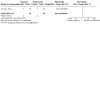
Comparison 1: Iloprost vs buflomedil, Outcome 5: Withdrawal due to study medication
1.6. Analysis.
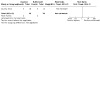
Comparison 1: Iloprost vs buflomedil, Outcome 6: Mortality
Comparison 2. Iloprost + rtPA vs buflomedil.
| Outcome or subgroup title | No. of studies | No. of participants | Statistical method | Effect size |
|---|---|---|---|---|
| 2.1 Incidence of amputations (patients) | 1 | Risk Ratio (M‐H, Random, 95% CI) | Totals not selected | |
| 2.2 Incidence of amputations (body parts) | 1 | Risk Ratio (M‐H, Random, 95% CI) | Totals not selected | |
| 2.3 Incidence of amputations (severity) | 1 | Risk Ratio (M‐H, Random, 95% CI) | Totals not selected | |
| 2.3.1 Superficial frostbite injuries | 1 | Risk Ratio (M‐H, Random, 95% CI) | Totals not selected | |
| 2.3.2 Deep frostbite injuries | 1 | Risk Ratio (M‐H, Random, 95% CI) | Totals not selected | |
| 2.4 Incidence of amputations (time) | 1 | Risk Ratio (M‐H, Random, 95% CI) | Totals not selected | |
| 2.4.1 12 h or less from frostbite to treatment | 1 | Risk Ratio (M‐H, Random, 95% CI) | Totals not selected | |
| 2.4.2 More than 12 h from frostbite to treatment | 1 | Risk Ratio (M‐H, Random, 95% CI) | Totals not selected | |
| 2.5 Withdrawal due to study medication | 1 | 31 | Risk Ratio (M‐H, Random, 95% CI) | Not estimable |
| 2.6 Mortality | 1 | 31 | Risk Ratio (M‐H, Random, 95% CI) | Not estimable |
2.5. Analysis.
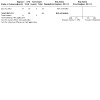
Comparison 2: Iloprost + rtPA vs buflomedil, Outcome 5: Withdrawal due to study medication
2.6. Analysis.
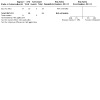
Comparison 2: Iloprost + rtPA vs buflomedil, Outcome 6: Mortality
Comparison 3. Iloprost vs iloprost + rtPA.
| Outcome or subgroup title | No. of studies | No. of participants | Statistical method | Effect size |
|---|---|---|---|---|
| 3.1 Incidence of amputations (patients) | 1 | Risk Ratio (M‐H, Random, 95% CI) | Totals not selected | |
| 3.2 Incidence of amputations (body parts) | 1 | Risk Ratio (M‐H, Random, 95% CI) | Totals not selected | |
| 3.3 Incidence of amputations (severity) | 1 | Risk Ratio (M‐H, Random, 95% CI) | Totals not selected | |
| 3.3.1 Superficial frostbite injury | 1 | Risk Ratio (M‐H, Random, 95% CI) | Totals not selected | |
| 3.3.2 Deep frostbite injury | 1 | Risk Ratio (M‐H, Random, 95% CI) | Totals not selected | |
| 3.4 Incidence of amputations (time) | 1 | Risk Ratio (M‐H, Random, 95% CI) | Totals not selected | |
| 3.4.1 12 h or less from frostbite to treatment | 1 | Risk Ratio (M‐H, Random, 95% CI) | Totals not selected | |
| 3.4.2 More than 12 h from frostbite to treatment | 1 | Risk Ratio (M‐H, Random, 95% CI) | Totals not selected | |
| 3.5 Withdrawal due to study medication | 1 | Risk Ratio (M‐H, Random, 95% CI) | Totals not selected | |
| 3.6 Mortality | 1 | 32 | Risk Ratio (M‐H, Random, 95% CI) | Not estimable |
3.5. Analysis.
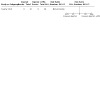
Comparison 3: Iloprost vs iloprost + rtPA, Outcome 5: Withdrawal due to study medication
3.6. Analysis.
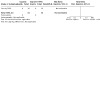
Comparison 3: Iloprost vs iloprost + rtPA, Outcome 6: Mortality
Characteristics of studies
Characteristics of included studies [ordered by study ID]
Cauchy 2011.
| Study characteristics | ||
| Methods |
Trial design: randomised, open label Mean follow‐up: 3 months Study duration: 12 years, from 1996 to 2008 Language: English/French Type of information: letter to editor and thesis |
|
| Participants |
Setting: 47 participants from 15 different nationalities were included directly after mountain rescue in the French Alps. Inclusion criteria: adults, no contraindications to use of study drug, no severe trauma, no hypothermia, no mental conditions preventing co‐operation to the treatment. Sex ratio: 44 men, 3 women. Allocation of participants: via a telephone service that was available 24 hours per day All groups: 47 participants total Intervention A (buflomedil): 15 participants Intervention B(iloprost): 16 participants Intervention C (iloprost plus rtPA): 16 participants Age: All groups: mean age 33.1 years Intervention A (buflomedil): mean age 35.4 years. Intervention B (iloprost): mean age 29.3 years. Intervention C (iloprost plus rtPA): mean age 34.7 years. Localisation of frostbite: All groups: feet alone: 18 (38.3%); hands alone: 14 (29.8%); feet and hands: 15 (31.9%) Intervention A (buflomedil): feet alone: 7 (46.7%); hands alone: 6 (40%); feet and hands: 2 (13.3%) Intervention B (iloprost): feet alone: 7 (43.8%); hands alone: 1 (6.25%); feet and hands: 8 (50%) Intervention C (iloprost plus rtPA): feet alone: 4 (25%); hands alone: 7 (43.8%); feet and hands: 5 (31.2%) Most serious grade of frostbite of participants: All groups: grade 2: 1 participant; grade 3: 36 participants; grade 4: 10 participants Intervention A (buflomedil): grade 2 = 1 participant; grade 3 = 12 participants; grade 4 = 2 participants Intervention B (iloprost): grade 2 = 0 participants; grade 3 = 14 participants; grade 4 = 2 participants Intervention C (iloprost plus rtPA): grade 2 = 0 participants; grade 3 = 10 participants; grade 4 = 6 participants More severe frostbite injuries were present in Intervention C. More patients in groups B + C had injuries on both hands and feet. |
|
| Interventions | All participants underwent rapid rewarming + received 250 mg of aspirin + 400 mg buflomedil IV, then were randomised to one of three IV regimens for 8 days: Intervention A: buflomedil 400 mg for 1 h per day Intervention B: prostacyclin (0.5 ng to 2 ng iloprost/kg/min for 6 h per day) Intervention C: prostacyclin (iloprost 2 ng/kg/min for 6 h/day) plus fibrinolysis (100 mg rtPA) for the first day only |
|
| Outcomes |
Outcome 1: digits amputated; time points: all stages < 12 h, all stages > 12 h. Outcome 2: adverse events: hot flushes, nausea, palpitations, vomiting |
|
| Notes |
Sample size calculation: not reported Sources of funding: not reported Conflicts of interest: none reported |
|
| Risk of bias | ||
| Bias | Authors' judgement | Support for judgement |
| Random sequence generation (selection bias) | Low risk | Randomisation from generated random list |
| Allocation concealment (selection bias) | Low risk | Participant randomised using a 24‐hour telephone service |
| Blinding of participants and personnel (performance bias) All outcomes | High risk | Study described as 'open label'. Blinding of participants and medical personnel was not described. The three interventions differed substantially in their mode of administration (infusion over 1 h vs infusion over 6 h vs infusion over 6 h plus a bolus). As such, it is hard to imagine that patients and personnel could be blinded to the intervention given. Therefore, we judged the risk of bias as high for blinding of patients and personnel. |
| Blinding of outcome assessment (detection bias) All outcomes | Low risk | Blinding of outcome assessors not described. The main outcome was amputation rate. Since the presence of an amputation is an objective fact and not a subjective judgement, we believe that the evaluation of this outcome cannot be subject to bias on the part of assessors. Therefore, we judged the risk of bias due to lack of blinding of outcome assessors as low. |
| Incomplete outcome data (attrition bias) All outcomes | Unclear risk | Number of withdrawals described, there were no withdrawals due to adverse events. However, in supplementary material, 7 patients were not seen at three month follow‐up (patient follow‐up at three months to confirm diagnosis). |
| Selective reporting (reporting bias) | Low risk | All patient‐relevant outcomes were included in the study |
| Other bias | Low risk | No other factors causing risk of bias were identified |
Abbreviations
iv: intravenous
rtPA: recombinant tissue plasminogen activator
Characteristics of excluded studies [ordered by study ID]
| Study | Reason for exclusion |
|---|---|
| Bouwmann 1980 | Not a RCT: 15 participants with bilateral symmetrical grade 3 to grade 4 frostbite treated with intra‐arterial reserpine in one limb and ipsilateral sympathectomy on the other, with 8 participants undergoing lumbar sympathectomy and 10 dorsal sympathectomy. |
| Edmonson 2008 | Not a RCT: over 3 years, 6 participants were prospectively enrolled for tenectaplase infusions and compared with 11 participants treated with retaplase over the preceding 2 years. |
| Espinoza 1981 | Not a RCT: involved 18 patients with different grades of frostbite injury who received long‐acting vasodilators. Quote: "the most frequently employed treatment was intra‐arterial reserpine ... the best response was in frostbite grade 1‐3, all grade 4 required amputation." |
| Golding 1963 | Not a RCT: 6 participants with bilateral grade 3 to grade 4 frostbite, unilateral regional sympathectomy performed on the more involved side, the contralateral extremity acted as a control. |
| Groechenig 1994 | Not a RCT: 5 participants with grade 2 to grade 3 frostbite all treated with IV iloprost, one with adjuvant heparinisation and cortisone. |
| Kaplan 1981 | Case report: grade 3 frostbite on 4 digits on left hand, regional sympathetic blockade with guanethidine, resulting in a 2 degree temperature rise and disappearance of cyanosis. |
| Martinez 1966 | Not a RCT: 8 participants with bilateral grade 2 to grade 4 frostbite; 7 underwent unilateral regional sympathectomy on the more involved side. |
| Movchan 2011 | Pseudo‐randomised open trial: retrospective data from 237 patients pooled with prospective data from 35 patients allocated to different groups according to the day of hospitalisation (even or odd). |
| Pasquier 2012 | Case report: regional nerve block in one patient with frostbite on both hands. |
| Shapovalov 2008 | Not a RCT: Quote: “The control group is healthy, the 1st groups were those who had inadequate behaviours or refused manipulations – no blockage. The 2nd group received treatment.” |
| Twomey 2005 | Not a RCT: 16 patients imaged with technetium bone scans in 1985‐1989 (no intervention, historical controls), compared to 19 participants in an open label trial who received either intravenous or intra‐arterial rtPA between 1989‐2003. |
Abbreviations
IV: intravascular
RCT: randomised controlled trial
rtPA: recombinant tissue plasminogen activator
Characteristics of ongoing studies [ordered by study ID]
NCT01270477.
| Study name | Study of the possible improvement in level of sequela and amputation/amputation level after frost injury by the adjuvant treatment of hyperbaric oxygen |
| Methods | The investigators hope to include at least 20 participants in a randomised manner, randomising to hyperbaric oxygen treatment, and half to no hyperbaric oxygen treatment. |
| Participants |
Inclusion criteria:
Exclusion criteria:
|
| Interventions |
Intervention: hyperbaric oxygen treatment for 2.5 h at maximum 14 meters Control: no hyperbaric oxygen treatment |
| Outcomes |
Primary outcome measure:
Secondary outcome measures:
|
| Starting date | 5 January 2011 |
| Contact information |
Principal Investigator: Helle Midtgaard, MD helle@fue.no Contact: Lene Mathisen, MD mathisen_lene@hotmail.com Hyperbaric Section Oslo University Hospital, Oslo, Norway |
| Notes |
ClinicalTrials.gov Identifier:NCT01270477 Other study ID numbers: FROST |
Differences between protocol and review
We planned to perform subgroup analyses for interventions initiated within or after 24 hours. However, the only included trial contained data on outcomes for interventions initiated within or after 12 hours. Thus, we altered our predefined time frame for the subgroup analyses to 12 hours in order to perform the subgroup analysis.
There were no other differences between the protocol and review.
Contributions of authors
Conceiving the review: AKL, CD, LP Designing the review: AKL, CD, LP Data collection for the review: AK, LP Data management for the review: AKL, LP Analysis of data: AKL, LP Interpretation of data: AKL, CD, LP Writing the review: AKL Providing general advice on the review: LP,CD
Final acceptance of the review: all authors
Sources of support
Internal sources
No sources of support supplied
External sources
-
National Institute for Health Research (NIHR), UK
Cochrane Infrastructure Funding to the Cochrane Injuries Group
Declarations of interest
AKL: none known
LP: none known
CD: none known
New
References
References to studies included in this review
Cauchy 2011 {published data only}
- Cauchy E, Cheguillaume B, Chetaille E. A controlled trial of a prostacyclin and rt-PA in the treatment of severe frostbite. New England Journal of Medicine 2011;364:189-90. [DOI] [PubMed] [Google Scholar]
- Cheguillaume B. A controlled trial of a prostacyclin and rt-PA in the treatment of severe frostbite [Essai contrôlé de l’iloprost et du rt-PA dans le traitement des gelures graves - doctoral thesis]. Available at: dumas.ccsd.cnrs.fr/dumas-00618697. Grenoble: Médecine Humaine et Pathologie, Université Joseph Fourier, Faculté de Médecine de Grenoble, 2011. [dumas-00618697] [DOI] [PubMed] [Google Scholar]
References to studies excluded from this review
Bouwmann 1980 {published data only}
- Bouwman DL, Morrison S, Lucas CE, Ledgerwood AM. Early sympathetic blockade for frostbite—is it of value? Journal of Trauma 1980;20:744–9. [PubMed] [Google Scholar]
Edmonson 2008 {published data only}
- Edmonson GR, Bretzman PA, Mohr WJ, Ahernholtz DH. Intra-arterial thrombolytic therapy for limb salvage in severe frostbite. Journal of Vascular and Interventional Radiology 2008;19(2 Suppl):S21-S22. [Google Scholar]
Espinoza 1981 {published data only}
- Espinosa GA. Management of frostbite injuries. Journal of the National Medical Association 1981;73(12):1125–31. [PMC free article] [PubMed] [Google Scholar]
Golding 1963 {published data only}
- Golding MR, DeJong P, Sawyer PN, Hennigar GR, Wesolowski SA. Protection from early and late sequelae of frostbite by regional sympathectomy: mechanism of "cold sensitivity" following frostbite. Surgery 1963;53:303-8. [PubMed] [Google Scholar]
Groechenig 1994 {published data only}
- Groechenig E. Treatment of frostbite with iloprost. Lancet 1994;344(8930):1152–3. [DOI] [PubMed] [Google Scholar]
Kaplan 1981 {published data only}
- Kaplan R, Thomas P, Tepper H, Strauch B. Treatment of frostbite with guanethidine. Lancet 1981;2:940–1. [PubMed] [Google Scholar]
Martinez 1966 {published data only}
- Martinez A, Golding M, Sawyer PN, Wesolowski SA. The specific arterial lesions in mild and severe frostbite: effect of sympathectomy. Journal of Cardiovascular Surgery 1966;7(6):495-503. [PubMed] [Google Scholar]
Movchan 2011 {published data only}
- Movchan KN, Kovalenko AV, Zinov’ev EV, Shutkin AV, Sidorenko VA, Donskov VV. Experience with surgical necrectomy for deep frostbite using physical means to influence the tissue. Vestnik khirurgii imeni II Grekova 2011;170(1):36-40. [PubMed] [Google Scholar]
Pasquier 2012 {published data only}
- Pasquier M, Ruffinen GZ, Brugger H, Paal P. Pre-hospital wrist block for digital frostbite injuries. High Altitude Medicine & Biology 2012;13:65–6. [DOI] [PubMed] [Google Scholar]
Shapovalov 2008 {published data only}
- Shapovalov KG, Burdinskii EN, Stepanov AV. Optimization of the components of regulation of vascular tone and microcirculatory hemostasis during prolonged regional block in local cold injury. Anesteziologiia i Reanimatologiia 2008;3:20-2. [PubMed] [Google Scholar]
Twomey 2005 {published data only}
- Twomey JA, Peltier GL, Zera RT. An open-label study to evaluate the safety and efficacy of tissue plasminogen activator in treatment of severe frostbite. Journal of Trauma 2005;59:1350-4. [DOI] [PubMed] [Google Scholar]
References to ongoing studies
NCT01270477 {unpublished data only}
- NCT01270477. Hyperbaric oxygen treatment as adjuvant treatment for frost injury [Study of the possible improvement in level of sequela and amputation/amputation level after frost injury by the adjuvant treatment of hyperbaric oxygen]. clinicaltrials.gov/ct2/show/NCT01270477 (first received 5 January 2011).
Additional references
Bruen 2007
- Bruen KJ, Ballard JR, Morris SE, Cochran A, Edelman LS, Saffle JR. Reduction of the incidence of amputation in frostbite injury with thrombolytic therapy. Archives of Surgery 2007;142(6):546-51. [DOI: 10.1001/archsurg.142.6.546.] [DOI] [PubMed] [Google Scholar]
Cauchy 2001
- Cauchy E, Chetaille E, Marchand V, Marsigny B. Retrospective study of 70 cases of severe frostbite lesions: a proposed new classification scheme. Wilderness & Environmental Medicine 2001;12(4):248-55. [PMID: ] [DOI] [PubMed] [Google Scholar]
Cauchy 2016
- Cauchy E, Davis CB, Pasquier M, Meyer EF, Hackett PH. A new proposal for management of severe frostbite in the austere environment. Wilderness & Environmental Medicine 2016;27(1):92-9. [PMID: ] [DOI] [PubMed] [Google Scholar]
Cheguillaume 2011
- Cheguillaume B. A controlled trial of a prostacyclin and rt-PA in the treatment of severe frostbite [Essai contrôlé de l’iloprost et du rt-PA dans le traitement des gelures graves - doctoral thesis]. Available at: dumas.ccsd.cnrs.fr/dumas-00618697. Grenoble: Médecine Humaine et Pathologie, Université Joseph Fourier, Faculté de Médecine de Grenoble, 2011. [dumas-00618697] [DOI] [PubMed] [Google Scholar]
Cheguillaume 2020 [pers comm]
- Cheguillaume B. Respectful request for a copy of the 2011 doctoral thesis of Benoit Cheguillaume [Demande respectuesement une copie d'une these de doctorat 2011 de BENOIT CHEGUILLAUME]. Email to: J Dennis (cc E Royle), Editorial team, Cochrane Injuries Group 9-10 November 2020. [dumas-00618697]
Egger 1997
- Egger M, Davey Smith G, Schneider M, Minder C. Bias in meta-analysis detected by a simple, graphical test. BMJ (Clinical Research Ed.) 1997;315(7109):629-34. [PMID: ] [DOI] [PMC free article] [PubMed] [Google Scholar]
Falconer 2018
- Falconer J. Removing duplicates from an EndNote library. Available at blogs.lshtm.ac.uk/library/2018/12/07/removing-duplicates-from-an-endnote-library.
Gluud 2006
- Gluud LL. Bias in clinical intervention research. American Journal of Epidemiology 2006;163(6):493-501. [PMID: ] [DOI] [PubMed] [Google Scholar]
GRADEpro GDT [Computer program]
- McMaster University (developed by Evidence Prime) GRADEpro GDT. Hamilton (ON): McMaster University (developed by Evidence Prime). Available at gradepro.org.
Grant 1992
- Grant SM, Goa KL. Iloprost. A review of its pharmacodynamic and pharmacokinetic properties, and therapeutic potential in peripheral vascular disease, myocardial ischaemia and extracorporeal circulation procedures. Drugs 1992;43(6):889-924. [PMID: ] [DOI] [PubMed] [Google Scholar]
Grieve 2011
- Grieve AW, Davis P, Dhillon S, Richards P, Hillebrandt D, Imray CH. A clinical review of the management of frostbite. Journal of the Royal Army Medical Corps 2011;157(1):73-8. [PMID: ] [DOI] [PubMed] [Google Scholar]
Handford 2014
- Handford C, Buxton P, Russell K, Imray CE, McIntosh SE, Freer L, et al. Frostbite: a practical approach to hospital management. Extreme Physiology & Medicine 2014;3:7. [PMID: ] [DOI] [PMC free article] [PubMed] [Google Scholar]
Hayes 2000
- Hayes DW Jr, Mandracchia VJ, Considine C, Webb GE. Pentoxifylline. Adjunctive therapy in the treatment of pedal frostbite. Clinics in Podiatric Medicine and Surgery 2000;17(4):715-22. [PMID: ] [PubMed] [Google Scholar]
Higgins 2002
- Higgins JP, Thompson SG. Quantifying heterogeneity in a meta-analysis. Statistics in Medicine 2002;21(11):1539-58. [PMID: ] [DOI] [PubMed] [Google Scholar]
Higgins 2011a
- Higgins JP, Green S, editor(s). Cochrane Handbook for Systematic Reviews of Interventions Version 5.1.0 (updated March 2011). The Cochrane Collaboration, 2011. Available from handbook.cochrane.org.
Higgins 2011b
- Higgins JP, Altman DG, Sterne JA, editor(s). Chapter 8: Assessing risk of bias in included studies. In: Higgins JP, Green S, editor(s). Cochrane Handbook for Systematic Reviews of Interventions Version 5.1.0 (updated March 2011). The Cochrane Collaboration, 2011. Available from handbook.cochrane.org.
Higgins 2011c
- Higgins JP, Deeks JJ, Altman DG, editor(s). Chapter 16: Special topics in statistics. In: Higgins JP, Green S, editor(s), Cochrane Handbook for Systematic Reviews of Interventions Version 5.1.0 (updated March 2011). The Cochrane Collaboration, 2011. Available from handbook.cochrane.org.
Higgins 2020
- Higgins JP, Eldridge S, Li T, editor(s). Chapter 23.1 Cluster-randomized trials. In: Higgins JP, Thomas J, Chandler J, Cumpston M, Li T, Page MJ, Welch VA, editor(s). Cochrane Handbook for Systematic Reviews of Interventions Version 6.1 (updated September 2020). Cochrane, 2020. Available from www.training.cochrane.org/handbook.
Hutchinson 2019
- Hutchinson RL, Miller HM, Michalke SK. The use of tPA in the treatment of frostbite: a systematic review. Hand 2019;14(1):13-8. [DOI: 10.1177/1558944718800731] [DOI] [PMC free article] [PubMed] [Google Scholar]
ICH‐GCP 1997
- International Conference on Harmonisation Expert Working Group. In: International conference on harmonisation of technical requirements for registration of pharmaceuticals for human use. ICH harmonised tripartite guideline. Guideline for good clinical practice CFR & ICH Guidelines. Vol. 1. Pennsylvania: Barnett International/PAREXEL, 1997.
Imray 2009
- Imray C, Grieve A, Dhillon S. Cold damage to the extremities: frostbite and non-freezing cold injuries. Postgraduate Medical Journal 2009;85(1007):481-8. [PMID: ] [DOI] [PubMed] [Google Scholar]
Keus 2009
- Keus F, Wetterslev J, Gluud C, Gooszen HG, Laarhoven CJ. Robustness assessments are needed to reduce bias in meta-analyses that include zero-event randomized trials. American Journal of Gastroenterology 2009;104(3):546-51. [PMID: ] [DOI] [PubMed] [Google Scholar]
Kjaergard 2001
- Kjaergard LL, Villumsen J, Gluud C. Reported methodologic quality and discrepancies between large and small randomized trials in meta-analyses. Annals of Internal Medicine 2001;135(11):982-9. [PMID: ] [DOI] [PubMed] [Google Scholar]
Lefebvre 2019
- Lefebvre C, Glanville J, Briscoe S, Littlewood A, Marshall C, Metzendorf M-I, et al. 4S1 Technical supplement to Chapter 4: Searching for and selecting studies. In: Higgins JP, Thomas J, Chandler J, Cumpston MS, Li T, Page MJ, Welch VA, editor(s). Cochrane Handbook for Systematic Reviews of Interventions Version 6. Cochrane, 2019. Available from training.cochrane.org/handbook/current/chapter-04-technical-supplement-searching-and-selecting-studies.
Lorentzen 2018
- Lorentzen AK, Penninga L. Frostbite - a case series from arctic Greenland. Wilderness & Environmental Medicine 2018;29(3):392-400. [DOI: 10.1016/j.wem.2018.03.001.] [DOI] [PubMed] [Google Scholar]
Lorentzen 2020
- Lorentzen AK, Davis C, Penninga L. Interventions for non-freezing cold injuries. Cochrane Database of Systematic Reviews 2020, Issue 10. Art. No: CD012980. [DOI: 10.1002/14651858.CD012980] [DOI] [PMC free article] [PubMed] [Google Scholar]
Macaskill 2001
- Macaskill P, Walter SD, Irwig L. A comparison of methods to detect publication bias in meta-analysis. Statistics in Medicine 2001;20(4):641-54. [PMID: ] [DOI] [PubMed] [Google Scholar]
Mäkinen 2009
- Mäkinen TM, Jokelainen J, Näyhä S, Laatikainen T, Jousilahti P, Hassi J. Occurrence of frostbite in the general population – work-related and individual factors. Scandinavian Journal of Work, Environment and Health 2009;35(5):384-93. [PMID: ] [DOI] [PubMed] [Google Scholar]
McIntosh 2014
- McIntosh SE, Opacic M, Freer L, Grissom CK, Auerbach PS, Rodway GW, et al. Wilderness Medical Society practice guidelines for the prevention and treatment of frostbite: 2014 update. Wilderness & Environmental Medicine 2014;25(4 Suppl):S43-54. [PMID: ] [DOI] [PubMed] [Google Scholar]
McMahon 2012
- McMahon JA, Howe A. Cold weather issues in sideline and event management. Current Sports Medicine Reports 2012;11(3):135-41. [PMID: ] [DOI] [PubMed] [Google Scholar]
Moher 1998
- Moher D, Pham B, Jones A, Cook DJ, Jadad AR, Moher M, et al. Does quality of reports of randomised trials affect estimates of intervention efficacy reported in meta-analyses? Lancet 1998;352(9128):609-13. [PMID: ] [DOI] [PubMed] [Google Scholar]
Moher 2009
- Moher D, Liberati A, Tetzlaff J, Altman DG. Preferred reporting items for systematic reviews and meta-analyses: the PRISMA statement. Journal of Clinical Epidemiology 2009;62(10):1006-12. [PMID: ] [DOI] [PubMed] [Google Scholar]
Murphy 2000
- Murphy JV, Banwell PE, Roberts AH, McGrouther DA. Frostbite: pathogenesis and treatment. The Journal of Trauma 2000;48(1):171-8. [PMID: ] [DOI] [PubMed] [Google Scholar]
Review Manager 2020 [Computer program]
- The Nordic Cochrane Centre, The Cochrane Collaboration Review Manager 5 (RevMan 5). Version 5.4. Copenhagen: The Nordic Cochrane Centre, The Cochrane Collaboration, 2020.
Roberts 2015
- Roberts I, Ker K, Edwards P, Beecher D, Manno D, Sydenham E. The knowledge system underpinning health care is not fit for purpose and must change. BMJ 2015;350:h2463. [DOI] [PubMed] [Google Scholar]
Robson 1981
- Robson MC, Heggers JP. Evaluation of hand frostbite blister fluid as a clue to pathogenesis. Journal of Hand Surgery 1981;6(1):43-7. [PMID: ] [DOI] [PubMed] [Google Scholar]
Savovic 2012
- Savovic J, Jones H, Altman D, Harris R, Juni P, Pildal J, et al. Influence of reported study design characteristics on intervention effect estimates from randomised controlled trials: combined analysis of meta-epidemiological studies. Health Technology Assessment (Winchester, England) 2012;16(35):1-82. [PMID: ] [DOI] [PubMed] [Google Scholar]
Schulz 1995
- Schulz KF, Chalmers I, Hayes RJ, Altman DG. Empirical evidence of bias. Dimensions of methodological quality associated with estimates of treatment effects in controlled trials. JAMA 1995;273(5):408-12. [PMID: ] [DOI] [PubMed] [Google Scholar]
Sweeting 2004
- Sweeting MJ, Sutton AJ, Lambert PC. What to add to nothing? Use and avoidance of continuity corrections in meta-analysis of sparse data. Statistics in Medicine 2004;23(9):1351-75. [PMID: ] [DOI] [PubMed] [Google Scholar]
Syme 2002
- Syme D. Position paper: on-site treatment of frostbite for mountaineers. High Altitude Medicine & Biology 2002;3(3):297-8. [PMID: ] [DOI] [PubMed] [Google Scholar]
Thompson 2002
- Thompson SG, Higgins JP. How should meta-regression analyses be undertaken and interpreted? Statistics in Medicine 2002;21(11):1559-73. [PMID: ] [DOI] [PubMed] [Google Scholar]
von Heimburg 2001
- Heimburg D, Noah EM, Sieckmann UP, Pallua N. Hyperbaric oxygen treatment in deep frostbite of both hands in a boy. Burns: Journal of the International Society for Burn Injuries 2001;27(4):404-8. [PMID: ] [DOI] [PubMed] [Google Scholar]
Wood 2008
- Wood L, Egger M, Gluud LL, Schulz KF, Juni P, Altman DG, et al. Empirical evidence of bias in treatment effect estimates in controlled trials with different interventions and outcomes: meta-epidemiological study. BMJ (Clinical Research Ed.) 2008;336(7644):601-5. [PMID: ] [DOI] [PMC free article] [PubMed] [Google Scholar]


